Text
Index
Section 1
Post A: Initial Ideas
Post B: Stranger Than Paradise
Post C: Coffee and Cigarettes
Post D: Only Lovers Left Alive
Post E to P: Source Review Sheets (Linked to in Post Q)
Post Q: Completed References List
Post R: Collated Quotes
Post S: Essay Abstract
Post T: Creative Investigation First Draft
Post U: Creative Investigation Final Draft
Section 2
Post A: Initial Ideas
Post B: Synopsis
Post C: Screenplay
Post D: Storyboard and Shot List
Post E: Reece Report
Post F: Casting and Direction
Post G: Shooting and Editing Schedules
Section 3
Post A: First Edit
Post B: Final Edit
Section 4
Post A: Evaluation
0 notes
Text
S4.Post A. Evaluation
In this evaluation I will be exploring the synthesis of my short film, Anti-Social Smokers, in relation to my creative investigation into director Jim Jarmusch. I will explore how my research into the filmography of Jim Jarmusch, specifically the films Stranger Than Paradise (1984), Coffee and Cigarettes (2003), and Only Lovers Left Alive (2014), has influenced and inspired my own short film. I will also explore how other aspects of A2 and AS film have allowed me to progress from consumer to filmmaker, as well as looking into how my proficiency as a filmmaker has improved since my AS short Film Ultraviolence.
Anti-Social Smokers is effectively a series of irreverent exchanges outside a party between Julian (Harrison Johnson) and Charlie (Sasha Mishenko) as they avoid the social scene within a party. The conversations are separated by cuts to black and the film ends with a daylight sequence which presents the sobering morning after the magic of the night is gone. The film explores the ideas of alienation from society and connection between outsiders I intended to convey. The protagonists of the film find solace outside with each other, and despite the fact they’re strangers they connect due to their misanthropic and individual personalities. The messages and values of my film convey countercultural ideas that are found within the American independent filmmaking scene of which Jarmusch belongs.
A Jarmusch staple is a monochrome cinematography. Jarmusch uses this filter to explore the ideas of displacement and being lost, and I used this in a similar way. I think the black and white cinematography is most effective in the ending sequence of my film, in which the aftermath of the night before and the absence of the characters is emphasised. The fact that the colours do not change between day and night gives a sort of otherworldly and endless tone. This is similar to some of the monochrome shots in stranger than paradise (1984) which are used to imply an endless America.
Anti-Social Smokers (2018)


Stranger Than Paradise (1984)

I used two DSLR cameras to shoot my film, and this allowed me to obtain a consistent two shot as well as obtaining additional shots that gave variety and made editing easier. I placed a monochrome filter on these cameras before editing and this was helpful as it gave me an idea of the look of the film before going into post production.
Anti-Social Smokers (2018)

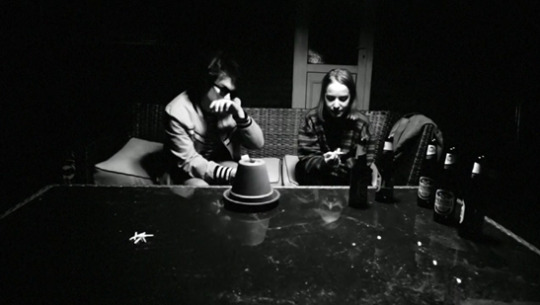
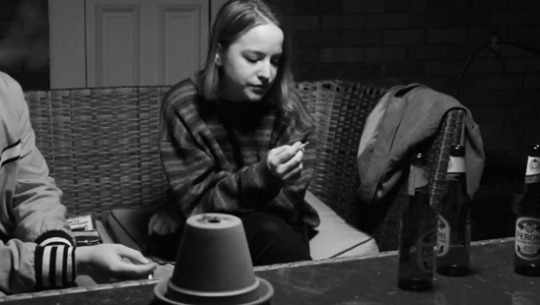
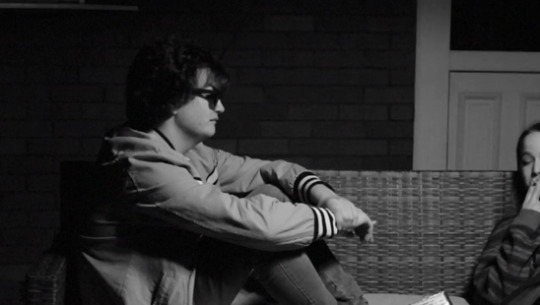
Coffee and Cigarettes (2003)
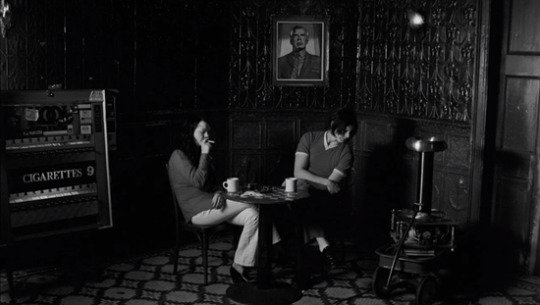
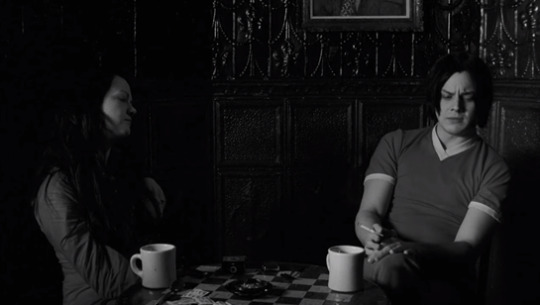
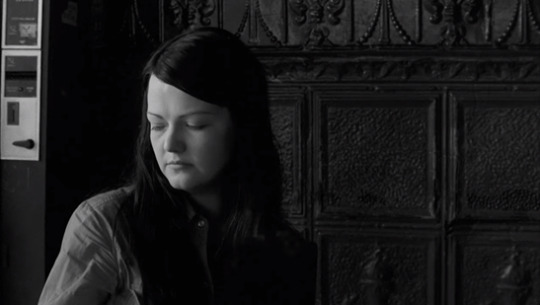

I decided to set the main sequence of Anti-Social Smokers at night, and then use the morning sequence to contrast this. The use of a single artificial light above the characters was effective as it made the rest of the set fade into the background and added a prominence to the shot composition of the characters in the two shots. The night time setting also made Julian and Charlie reminiscent of the characterisation of Adam and Eve in Only Lovers Left Alive (1984), and the fact that they are absent from the morning sequence gives an implication that they have a preference of a night. They are nocturnal but, contrasting Only Lovers Left Alive (1984), this is out of preference rather than necessity.
Anti-Social Smokers (2018)
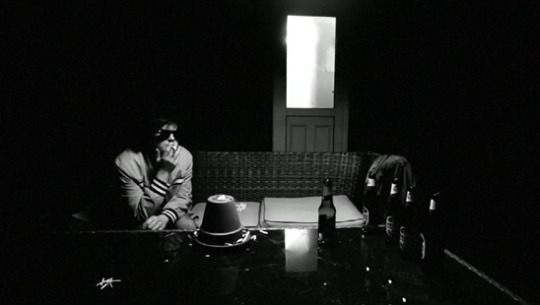

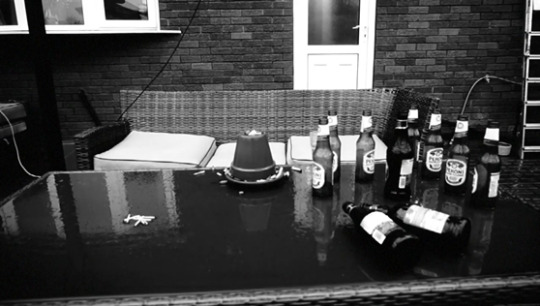
Only Lovers Left Alive (2014)


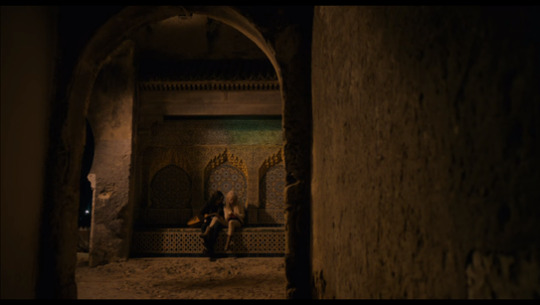
In terms of editing, the research into the standardised procedure of Coffee and Cigarettes (2003) was extremely helpful in creating my film. By using an overhead shot I was able to edit the film’s dialogue in order to give the narrative a more natural feel. I was also able to give a very personal feel to the film by using simplistic shots that focused on the characters, and contrasting these shots with close ups of the set gave an empty and otherworldly feel to the location. This instilled an up close and private feel to the Anti-Social Smokers, as if these two people were the only two people in the world.
Anti-Social Smokers (2018)
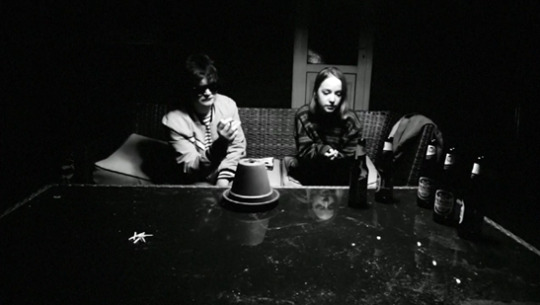


Coffee and Cigarettes (2003)

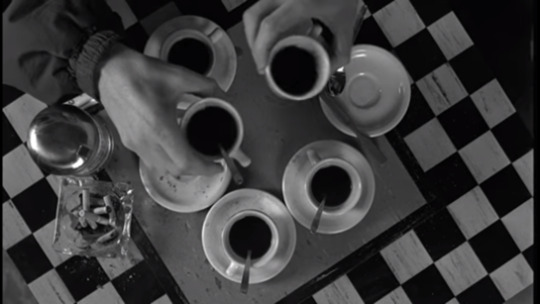

Influenced by the fact Jim Jarmusch used music written by his band SQURL for Only Lovers Left Alive (2014), I decided to write and record the score for my film. The score is reverberated and repetitive in order to give a mystical feel to the film’s sound and adds to the late night aesthetic of the film. It also influences the meaning of the film, as the characters are scored with a strange, subversive type of music used to subvert the expected music playing within the party they are escaping from.
I tried to incorporate themes that I identified as reoccurring in Jarmusch’s filmography during my creative investigation, including outsiders, counter culturalism and existential ideas. I also included some signature Jarmusch iconography such as cigarettes, thrifty costumes and urban setting. The narrative of my short film is deeply rooted in the idea of the two main character’s being ‘outsiders’. Charlie and Julian are alienated by the culture inside the party, and find more meaning outside with each other. I left a lot of the plot ambiguous, such as location and period, to give the film a more relatable style. This communicates to the audience that context is irrelevant, what is relevant is the interaction between the two characters. Elements of the film, such as the monochrome cinematography and ambiguous dialogue, add to this unidentifiable setting.
Anti-Social Smokers (2018)

Coffee and Cigarettes (2003)

Along with my creative research, Anti-Social Smokers was also influenced by my entire study of AS and A2 film. Specifically, I found Richard Ayoade’s postmodern coming of age film Submarine largely influential. In terms of dialogue and narrative wise my film was heavily influenced by Submarine. The subtle and wry humour of Ayoade is similar to Jim Jarmusch, and the use of binary opposition to explore the relationship between Oliver and Jordana influenced the characterisation of Charlie and Julian. Submarine is a story of outsiders falling in love, much like the films of Jim Jarmusch.
Anti-Social Smokers (2018)
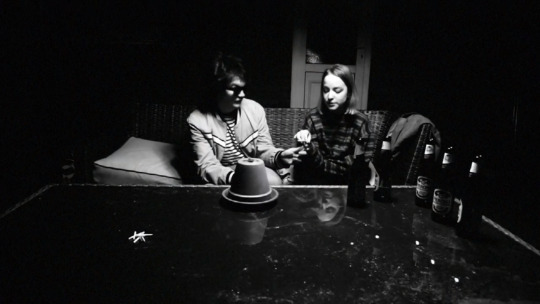
Submarine (2010)

I believe I have progressed as a filmmaker since my A1 creative project, and my technical and creative proficiency has improved to the extent that Anti-Social Smokers is a much more refined compared to Ultraviolence, my previous short film. The content of the two films differ massively, Anti-Social Smokers being a short inspired by the work of Jim Jarmusch and Ultraviolence being a short inspired by the films Nightcrawler (2014, Dan Gilroy) and There Will Be Blood (2007, Paul Thomas Anderson). I think the aim of Anti-Social Smokers was much more achievable as the genre of coming of age was of a much more manageable than the thriller genre, as these require a lot more action and are less applicable to independent film. However, there are some similarities between Anti-Social Smokers, such as the casting of Harrison Johnson, the droning score and the darkly palliated cinematography.
Anti-Social Smokers (2018)
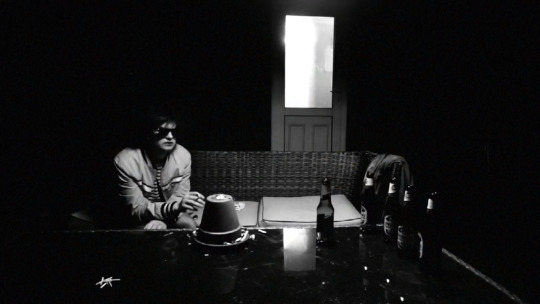
Ultraviolence (2017)

I think my A2 film was successful, and although some adjustments were made during the synthesis of the film, I believe I created a film which both reflects my individual filmmaking style and the influence of my creative investigation. I was able to conduct an investigation into Jim Jarmusch’s filmography, and through research and planning move from a consumer of Jarmusch’s product to a filmmaker influenced by the director. I think Jim Jarmusch’s earlier work influenced my film stylistically, whereas his later films such as Only Lovers Left Alive (2014) and Paterson (2016) influenced my film thematically. The planning I conducted through my blog allowed me to lay out each aspect of my film and was integral to the synthesis of my product.
0 notes
Text
S3.Post B. Final Edit
https://www.youtube.com/watch?v=ITxvChR7jHs&t=4s
youtube
0 notes
Text
S3.Post A. First Edit
youtube
https://www.youtube.com/watch?v=gjj5ta21X2I
This is the first draft of my A2 film. I think it is a good base to further edit, and what I need to focus on is my sound editing and making the sequences smoother. So far I am pleased with how my film is turning out as it reflects both the influence of Jim Jarmusch on my filmmaking as well as my individual style. I also believe I made the right choice in casting Sasha and Harrison as they definitely add to the aesthetic of the film. I think the film at this point has a feel which is definitely reminiscent of Jarmusch’s Coffee and Cigarettes short however I have incorporated elements of my other focal films.
0 notes
Text
S2.Post G. Shooting and Editing Schedules
Shooting and editing
Wednesday 14th February 2018
Sunday 18th February 2018
Monday 19th February
I initially planned to film on Wednesday the 4th of February, as this lined up well with my actors and my schedule. Relative to this I planned to begin editing on Monday the 19th of February. However, when looking at the practical considerations closer to the date I cancelled that date as the weather conditions were poor, with high winds and rain. I would have been unable to film in this weather as the location would have been excessively wet and the wind would have interfered with the sound. Instead, I contacted my actors regarding availability and was able to schedule a shoot on Sunday the 18th of February, as this is a date with good weather conditions and I do not have to revise my editing schedule. I am going to film 5 o’clock onward as dusk will have passed and the lighting will be dark, which is appropriate for my narrative.
Log dates of editing
Edit 26/02/18


I collected all my shots and added them to a year 2 folder in Final Cut pro. I then renamed the shots to which scene they are a part of to avoid confusion due to the consistent location. Next I created a skeleton edit as a very rough edit which allows me to see the order of my shots, if there are any shots I need to rethink or reshoot, and to see the total amount of footage I have so far. I have not yet cut anything in my skeleton edit. I based the order of the shots I have on my storyboard.
Edit 27/02/18

I have begun to cut down my Skeleton edit and establish each scenes. i have established the first two scenes in order however the cutting is not yet perfect. Doing this is useful as it has allowed me to identify close ups I may need to reshoot and it has helped me establish the pace of my film, which is useful for when i begin to consider sound editing.
Edit 05/03/18

I have finished cutting of my Skeleton edit. Doing this has allowed me to identify the order of my shots, where potential reshoots could occur, additional shots I can add, and sound editing i need to undertake.
Rough Edit 06/03/18
This is a very rough draft of my A2 film.
https://www.youtube.com/watch?v=wATSY0EP7g0&t=3s
22/03/18
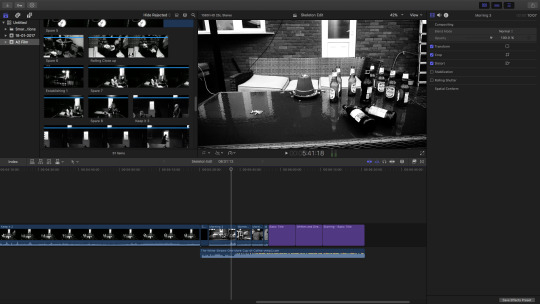
In this edit I started looking at sound and added a music score to the main sequence. I also added a score to the morning sequence. I think this adds to the atmosphere of this sequence and makes it more sobering.
0 notes
Text
S2.Post F. Casting and Direction
Harrison Johnson
Headshot
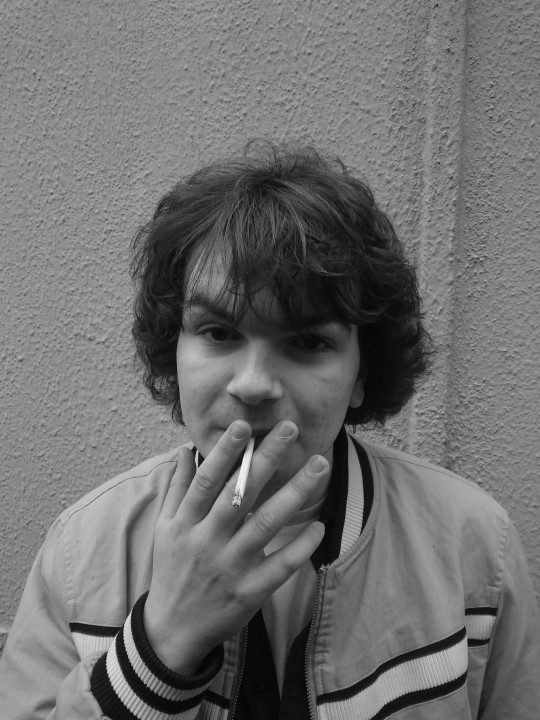
Screentest
https://www.youtube.com/watch?v=jGfF1Idxlz4
Sasha Mish
Headshot

Screentest
https://www.youtube.com/watch?v=TWvt7hKAQXA
Cam Edmondson
Headshot

Screentest
https://www.youtube.com/watch?v=WbsRmZrJa2E
Ruby Seddon Wilson
Headshot

Screentest
https://www.youtube.com/watch?v=mlJdFLwy1y0
Mason Shillito
Headshot

Screentest
https://www.youtube.com/watch?v=0exreAQEPsY
Links to Creative Investigation
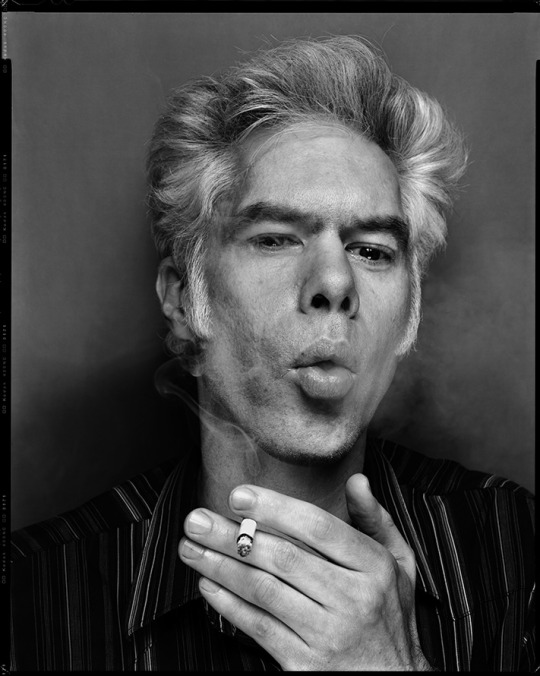
I think all the actors I considered have a look of a Jarmusch character. In my screen tests I edited the videos slightly, taking off the sound and filming with a monochrome filter, to give a minimalist style. This helped me decide on which actors would be the most suitable for the style of my final film. in the end I have decided on casting Harrison Johnson as Julian and Sasha Mishenko as Charlie. I have chosen these actors as they are how I envisioned the characters, irreverent and reserved in their personality and body language, and I think to create the film I want they are the most suitable people.
0 notes
Text
S2.Post E. Reece Report
Location 1: Garden Set

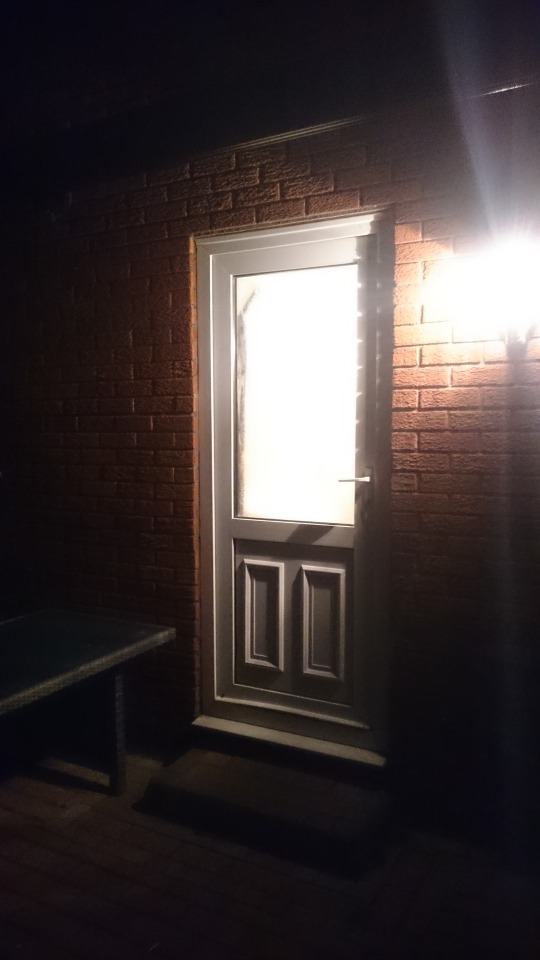


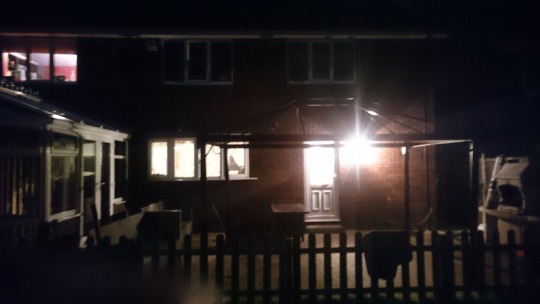

Choice of Location
I think this is a very effective location for my film. It is readily available as it is my own house, and besides the convenience aspect this means I will be able to control the set and the surrounding location easier. Furthermore, the location is suitable to the atmosphere in my film, it is enclosed yet open to the sky, and the furniture available adds to the set.
Lighting and Sound
The natural lighting in this set is very atmospheric, and would be suitable for contrasting in monochrome. Furthermore a light is available to hang from the gazebo which can be placed centrally in order to light the actors and their cigarettes. Furthermore either through coloured lights or use of some form of coloured film placed on the window the light from the interior of the house could easily be made to resemble party lighting.
Hazards and Precautions
The shooting will be outside and due to current weather conditions the temperature may be hazardous. in order to ensure the safety of the actors I will look into a heating lamp and the cast and crew may need to take breaks inside.
Location 2: House Interior
Choice of Location
The house interior will be useful as there are multiple locations suitable for my quick cuts that add into my main sequence.
Lighting and Sound
Again the lighting of the interior of the house could be easily made to resemble a party through various techniques.
Hazards and Precautions
In terms of hazards their are the normal risk associated with interior filming, such as placing equipment in limited space. The shot which involves the spilling of drinks will have to be carefully controlled to ensure nothing is broken or smashed.
Location 3: Bus Stop
Choice of Location
This location is suitable to film in as it is very quite and there is little foot traffic, especially early on.
Lighting and Sound
The lighting is very bright and sobering at the early hours of the morning. The sound is very quite and their is little ambient noise that would interfere with filming.
Hazards and Precautions
I must ensure actors do not stray to close to the road during film and I will also have to make reference to bus times as I do not want to cause confusion for the local bus service.
Risk Assessments

Talent Release Forms
Link to Creative Investigation
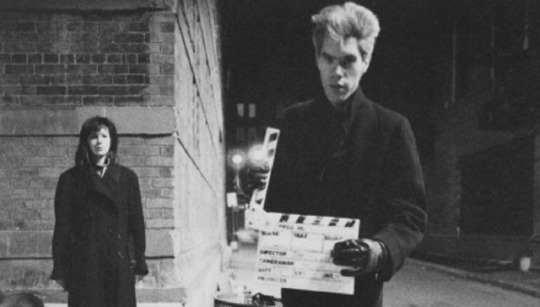
My choice of locations resemble some of the settings in Jarmusch films. An isolated area outside, with two characters sitting over a table, is inspired by the formulaic settings of Coffee and Cigarettes (2013). The nighttime shooting time will also allow me to get lighting and cinematography inspired by the nocturnal aesthetic of Only Lovers Left Alive (2014). Finally, the concrete and barren look of the morning location is inspired by the monotonous american landscape the characters of Stranger Than Paradise (1984) inhabit.
0 notes
Text
S2.Post D. Storyboard and Shot List
Storyboard
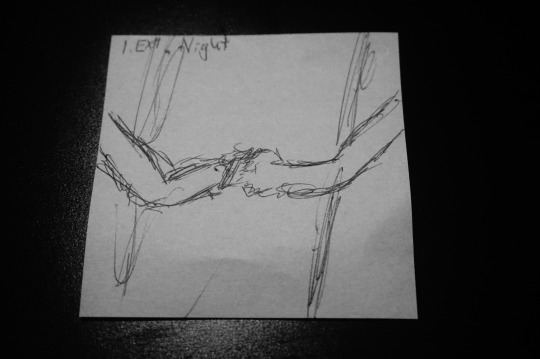
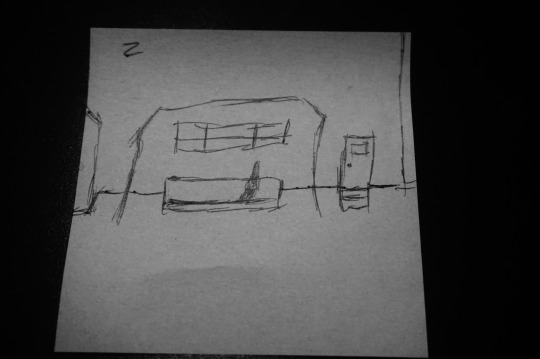


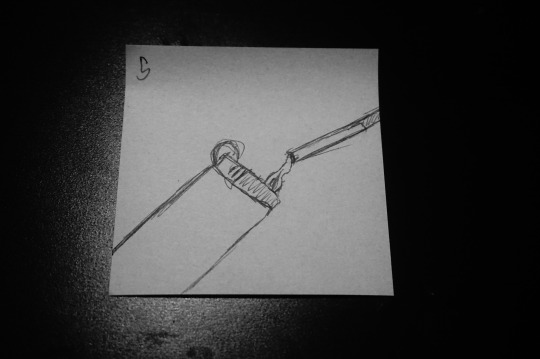
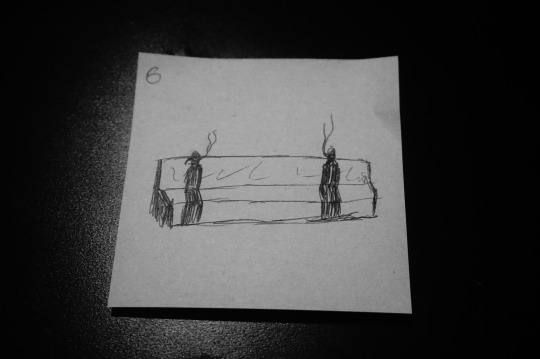
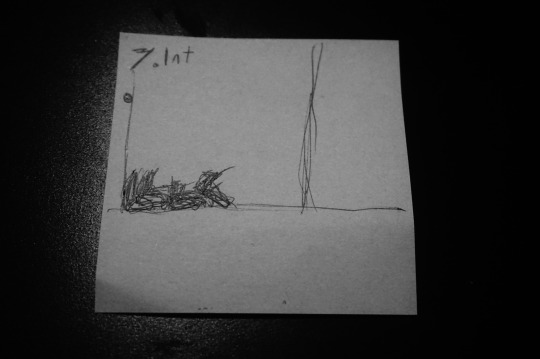
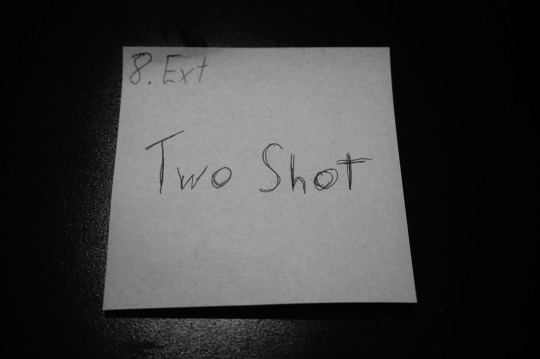

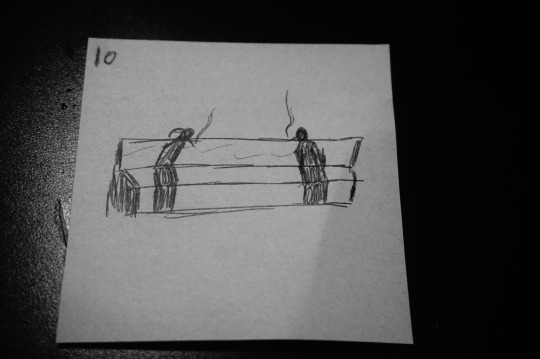
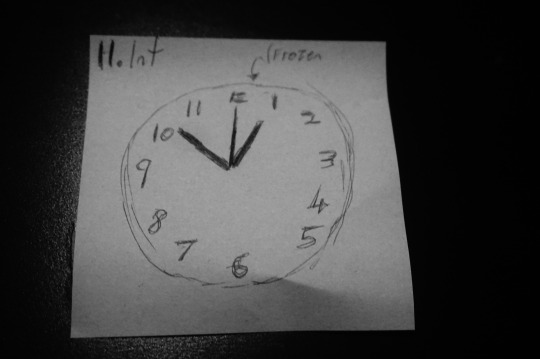
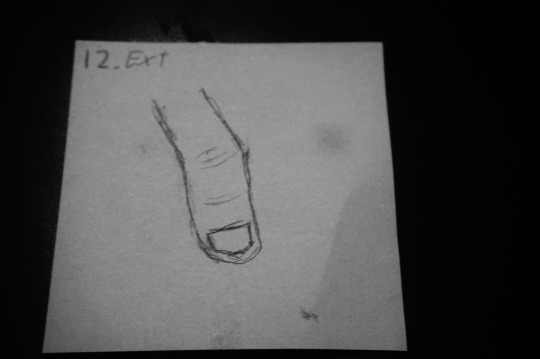
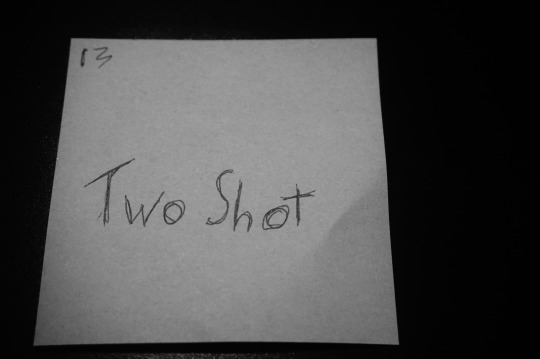
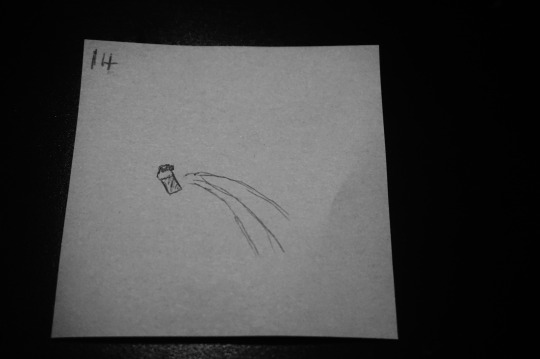

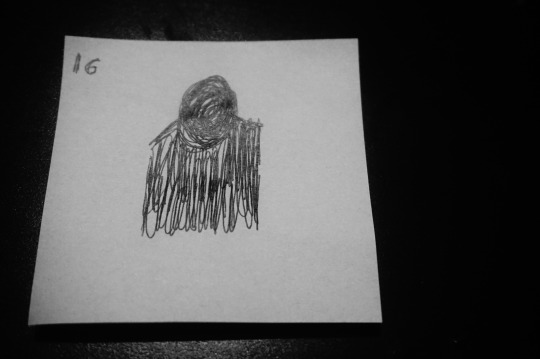
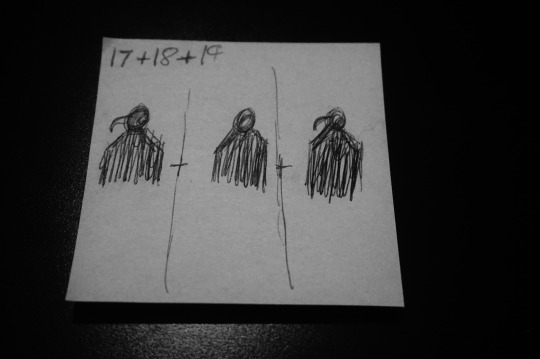


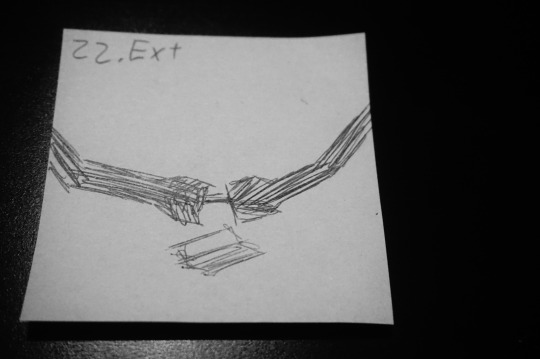

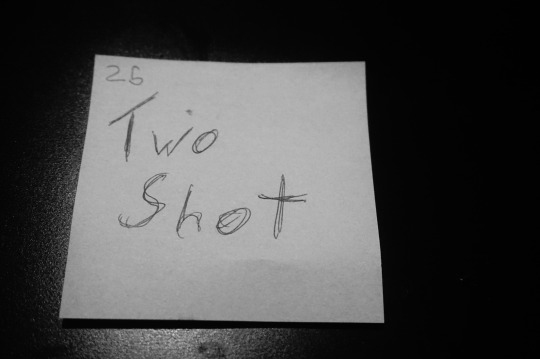
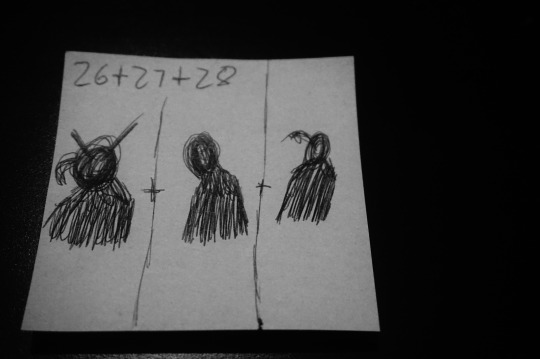
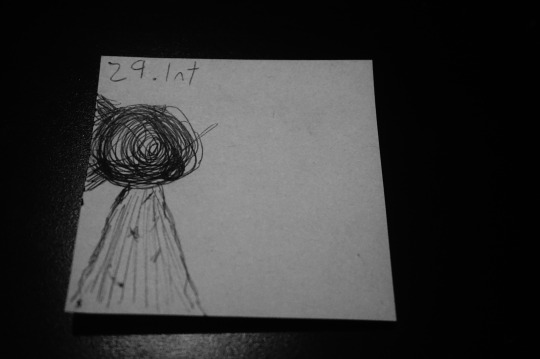
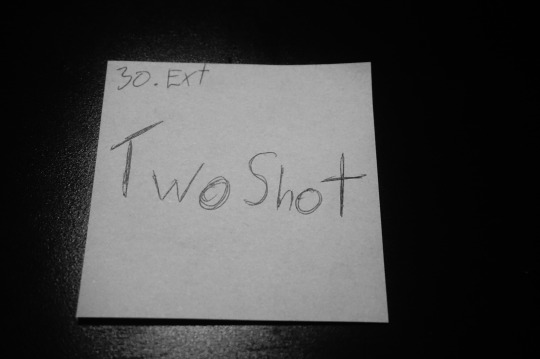
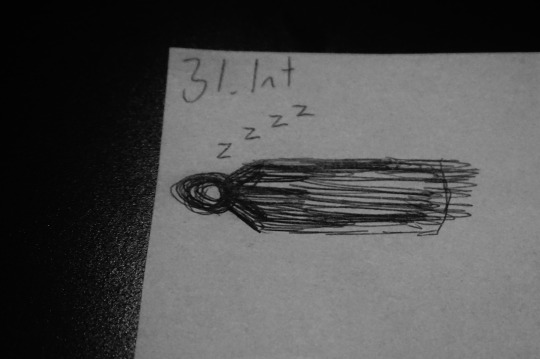


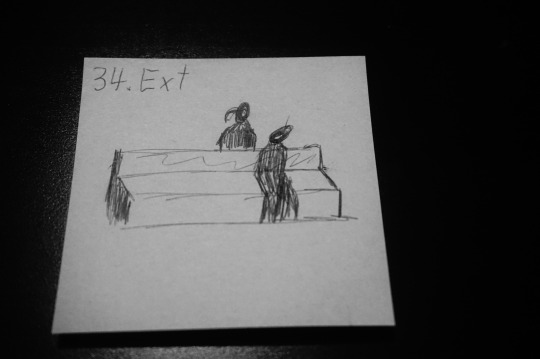
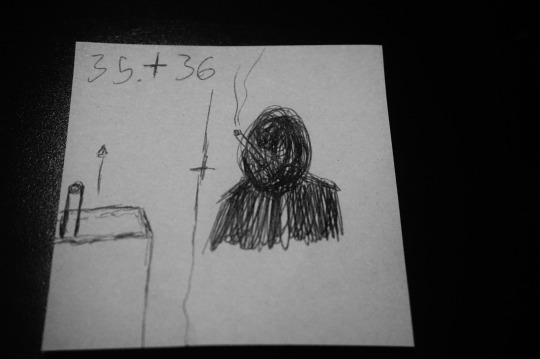
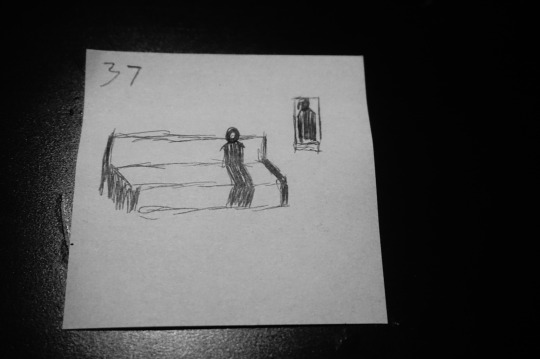
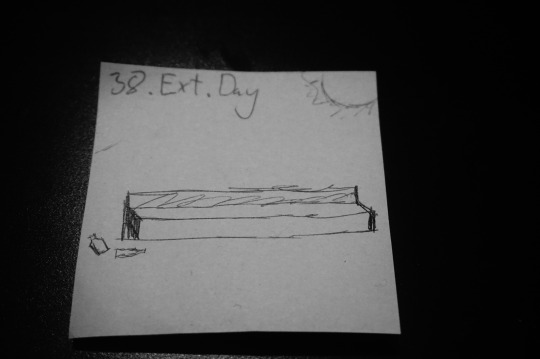

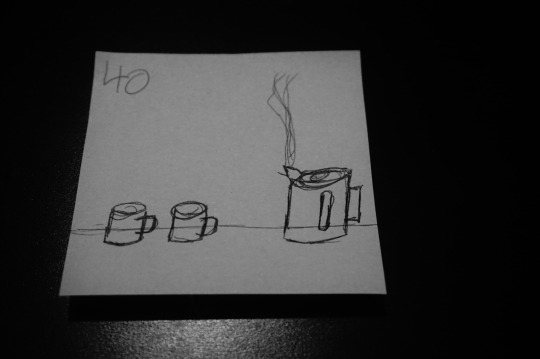

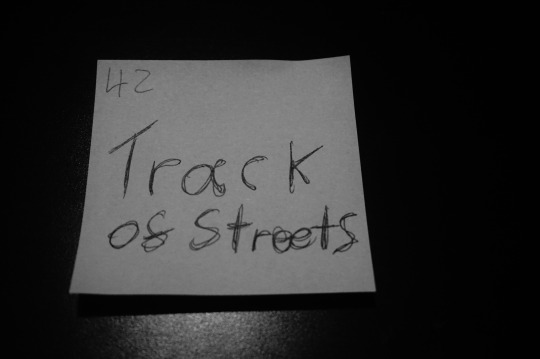
Shotlist
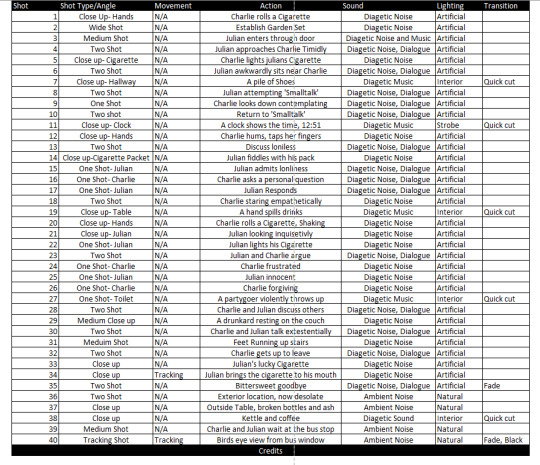
Links to Creative Investigation

I have sequenced my film very much in the style of Jarmusch. One long scene makes up the main body of the film and the shots are formulaic of a Coffee and Cigarettes (2003) vignette. This includes the heavy use of two and one shots. However I have included the addition of quickly cut shots inside the party which are intended to contrast the main sequence. There is also a sort of epilogue which makes up the morning sequence, that is used to establish the longer connection between the characters and to make the film more substantial in variation and originality.
0 notes
Text
S2.Post C. Screenplay
Second Draft
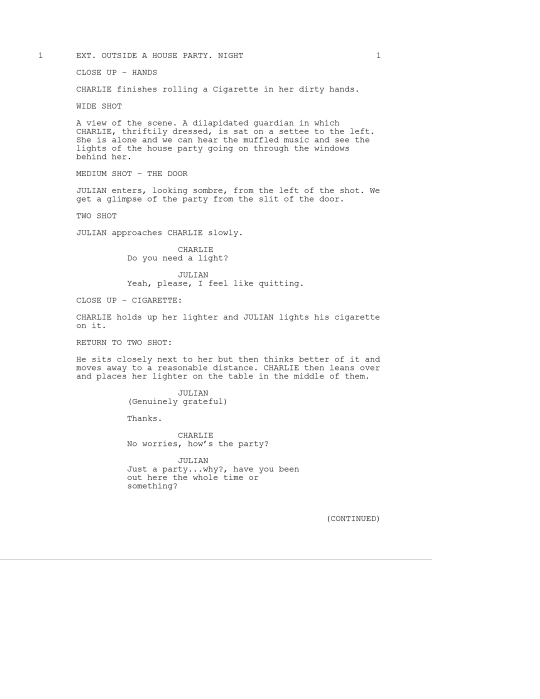

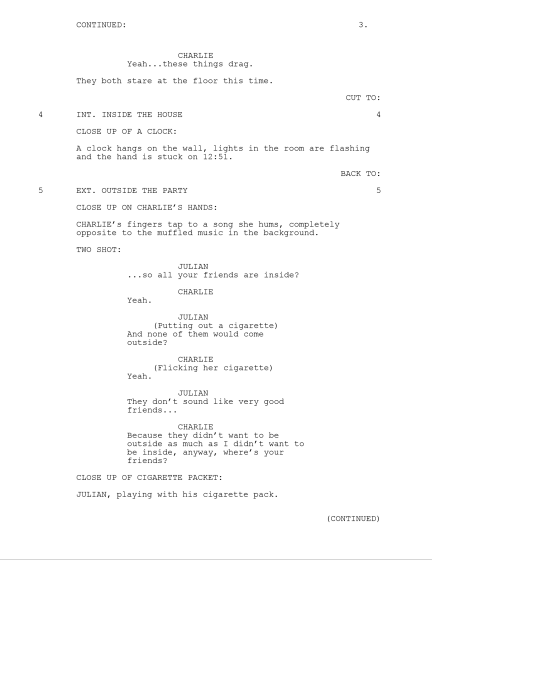
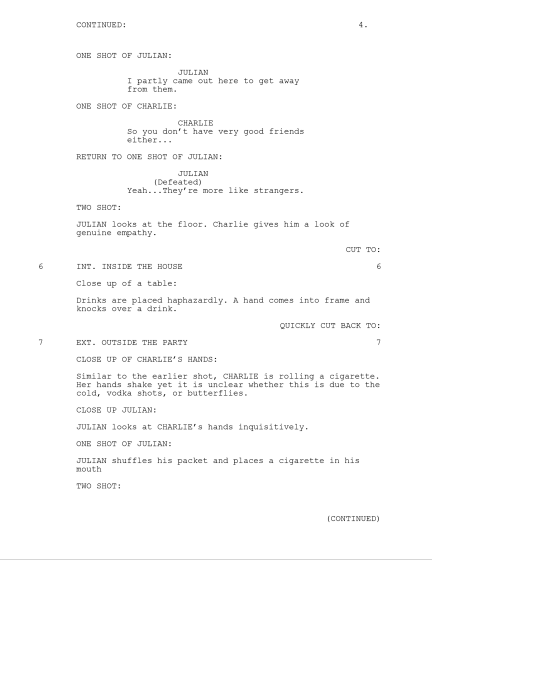




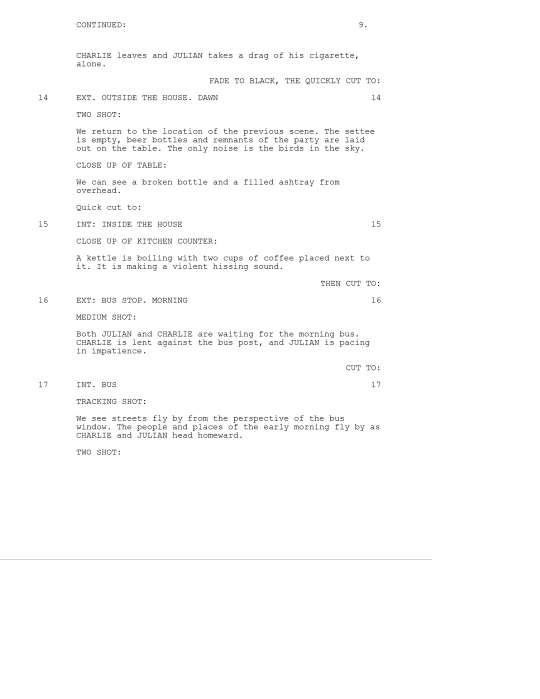
First Draft
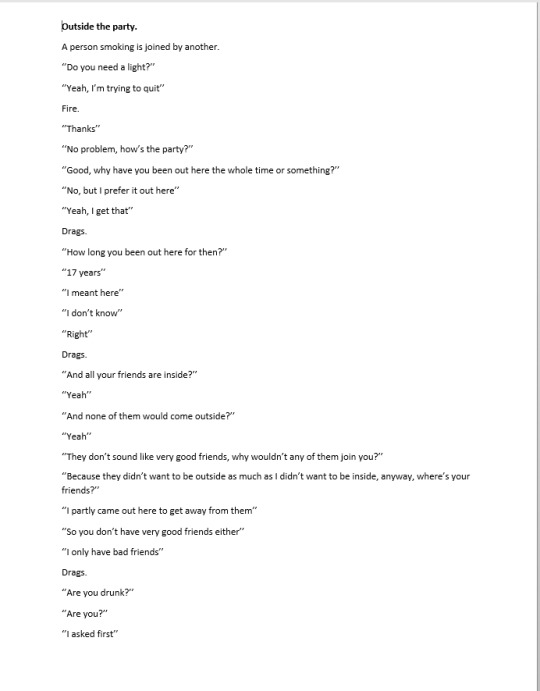
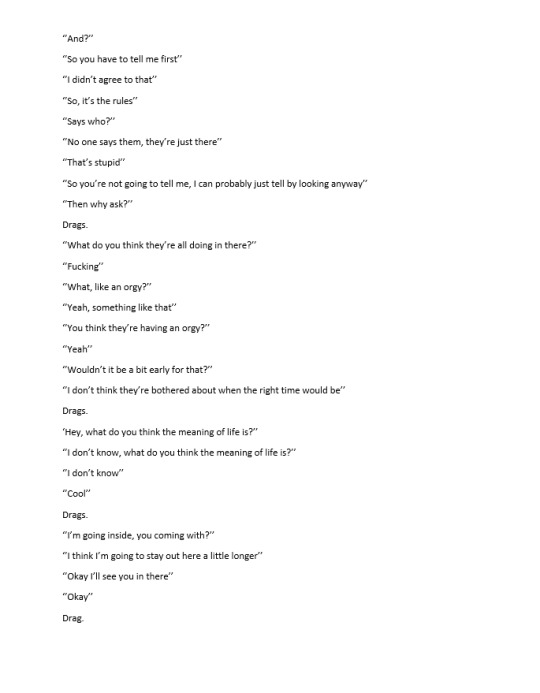

Link to Creative Investigation
My script is both original and inspired by a Jarmusch script. There is a focus on dialogue, with the themes of that dialogue being both existentialist and irreverent, The character’s are outsiders, yet are the type of outsider relative to my experience and style as opposed to a Jarmusch outsider. There is a minimal focus on plot and action as these are not how meaning is created in a Jarmusch script.
0 notes
Text
S2.Post B. Synopsis
Summary
Two disillusioned teenagers talk about life, everything, and nothing. This all takes place outside of a house party as the two are smoking cigarettes.
The two main character’s are Julian and Charlie. They are both outsiders who bond over their alienation from the rest of society.
The first act is the two meeting, the second act is the conversation in which the two connect, and the third act is the two leaving together. This narrative structure is based on
Logline
Two nicotine addicts talk about life, everything, and nothing, all whilst avoiding a party.
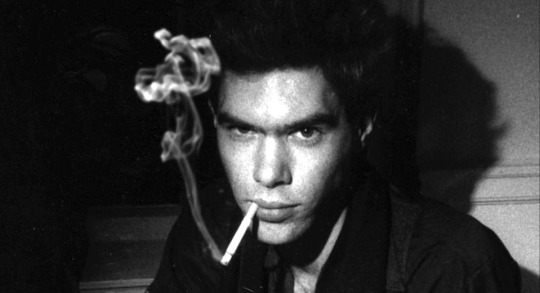
Links to Creative Investigation
I think that my setting and synopsis are very reminiscent of Jarmusch, yet at the same time personal to me. I have took a seemingly typical situation, and decided to use that situation to explore meaning and relationships, much like the Coffee and Cigarettes vignettes with their seemingly innocent cafes. The log line is vague and gives insight into the meaning of the film before hinting at the plot. The log line reflects how the concept, much like a Jarmusch film, is focused on meaning and character over plot and narrative
0 notes
Text
S2.Post A. Initial Ideas
Influence of my Creative investigation on cinematography / mise en scene / editing / sound in my short film.
Cinematography
Black and white colouring will be used as it is calm and a Jarmusch signature. It conjures up the subversive tone of American independent films.
Use of the coffee and cigarettes shots, establishing shot, two shot, one shots for each character, overhead shot, I will use these shots but not adhere just to them. This means my film will be based on the Coffee and Cigarettes formula established by Jim Jarmusch, but I will build on this formula.
Long shots will set the cool, contemplative tone of the film.
My lighting will contrast the black and white, however I will not have any oppressive blacks as this will make a sinister tone and i want to avoid this. I will centrally focus the lighting on characters.
Mise en scene
Cigarettes will be a thematic device, reflecting.
Youthful, bohemian characters will be cast, and characters may be slightly built on actors.
Editing
Long shots, and cuts between shots. However based on the setting of my film largely taking place outside of a party, in between shots I will quickly cut to shots of the party. This will contrast with the cool, existential main narrative.
Sound
I will consider a slow, contemplative music for the main sequence, and then more intense music for the party cuts.
I will put diegetic influence on the sound of the cigarettes and the lighters, as this is satisfying.
There will be large thematic focus on the character’s dialogue.
Influential short films
WHISKY TIME WITH JOSH TILLMAN
youtube
https://www.youtube.com/watch?v=l4JzFm1XZ1g
Directed by Brian Lee Hughes
Cinematography
The short film is made up of a one shot, much like the main shot type in the Coffee and Cigarettes short Renee.
Mise en scene
The short film casts a musician, Father John Misty (Josh Tillman)
There is thematic use of Cigarettes
The dialogue is humorous, wry like a Jim Jarmusch movie, and Misty’s intoxication has led to improvisation.
Editing
The film is one long shot.
A black shot is used at the begging to introduce the shot, much like a Jarmusch transition.
Sound
There is only diagetic sound made by Father John Misty.
The Sun of the Natural world is Pure Fire
youtube
https://www.youtube.com/watch?v=Z3wV5qF94EA
Genre (iconography and conventions) – Influence of C.I.
The film will subvert the conventions of a teen film, influenced by the subversion of Jim Jarmusch, as he can explore outsiders from any walk of life. In terms of ‘teen’ conventions that will be subverted: the setting of the party will be present but drama will not come from the party; the character’s will bond over their outsider nature but it will be celebrated as opposed to creating conflict with the rest of the world like in teen films; a piece of iconography subverted will be cigarettes as these are normally an affectation of negative characters in teen films, however they will be celebrated in this film.
Narrative (plot synopsis, narrative structure, characters) - Influence of C.I.
The film focuses on the dialogue of two characters speaking and sharing cigarettes outside of a party. The characters will bond of their outsider nature and contrasted with the others at the party. The dialogue will be existential and the characters will share a certain outlook on life. The characters will then wander home, drifting, alone together.
Narrative structure
The narrative structure will be an established equilibriums in which the two are outsiders who have happened to meet each other, the change will be them slowly connecting as they talk, and the new equilibrium is the two now being connected outsiders, drifting alone together.
Character 1: Julian. Male. 17 (As this is an in-between age, the nowhere age)
Julian smokes cigarettes, he is egotistical but only to hide his vunerability and lonliness. He is an outsider and mostly doesn’t care about other people. He is vintagely dressed as he simultaniously cares and doesn’t care about his appearance. He is slightly drunk in the main sequence, as this has helped deal with the social situation.
Character 2: Charlie. Female. 18 (-ish, could be older, could be younger)
Charlie is a complete outsider and reluctant to open up to people. She doesn’t show much emotion. She is world weary at such a young age, her personality is older than her age. She is thriftily dressed, as if she’s given up. She seems sober, however she is the type who could be dead drunk and no one would notice. However despite how emotionless she is, she does seem to build a relationship with Julian.
Messages / values - Influence of C.I.
Much of Jarmusch’s work focuses on character development and interactions over plot and messages, so the messages and values of my film will be subtle within it. However, what I will focus on the two outsiders finding solace and companionship with each other due to being similarly alienated by their society. This is a value reminiscent of the values of the outsiders presented in Jarmusch’s work.
Links to C.I Film Trailers
youtube
https://www.youtube.com/watch?v=MwefGellnhk
youtube
https://www.youtube.com/watch?v=ycOKvWrwYFo
youtube
0 notes
Text
Post U. Creative Investigation Final Draft
Creative Investigation
This essay will focus on director Jim Jarmusch, an American independent filmmaker whose vast catalogue of films have been influential to the development of cinema as an art form and has inspired a myriad of artists. Journalist Peter Keogh outlines Jarmusch’s influence in an interview, stating to the director that ‘Since ‘Stranger Than Paradise’ your sensibility and style seem to be dominant in American independent film-making, and also in film-making around the world’. (Keogh, 1992). Despite Jarmusch’s critical acclaim he has not achieved the commercial acclaim he arguably deserves. His subversion of mainstream cinema in his films, such as in the vignette based Coffee and Cigarettes (2003), the culturally underground Stranger Than Paradise (1984), and the unconventional vampire genre piece Only Lovers Left Alive (2014), have led the way in countercultural filmmaking. Richard Dyer outlined the aspects of art films; they are edifying, elitist, refined and difficult to understand (Dyer, 1992). It’s Jarmusch’s sensibility as an artist and an auteur which has led to this overshadowing of critical acclaim over commercial acclaim.
Auteur theory was first introduced, by the Cahiers de Cinema critics such as Andre Bazin and Alexandra Astruc, as a way to distinguish the filmmaker as an author/auteur. French filmmaker Francois Truffaut coined the term ‘’la politique des auteurs’’ in ‘Une Certaine Tendance du Cinema Francais’, arguing that auteurs have a distinctive style established by consistent themes and ideas. The theory has been adopted by many critics, including American Andrew Sarris who, in Notes on Auteur Theory in 1962, established three circular premises of auteur theory: ‘the outer circle as technique; the middle circle, personal style; and the inner circle, interior meaning’ (Sarris, Keith Grant, 2008) .
Aims of Research
In this essay I will attempt to answer whether Jarmusch can claim full authorship of his films based on the research I have conducted. The subtopics I will look at are distinguishable style, consistent themes and the influence of collaborators. I will use auteur theory, mainly Andrew Sarris’ premises of auteur theory, and analysis of Jarmusch’s filmography to explore Jarmusch’s claim to authorship.
Annotated primary Sources
Stranger Than Paradise. (1984). [film] Directed by J. Jarmusch. USA: Cinesthesia Productions, Grokenberger Film Produktion, Zweites Deutsches Fernsehen (ZDF). Stranger than paradise is Jarmusch first substantial film and received mass critical acclaim, winning the Camera D’Or at the 1984 Cannes film festival. The film is an exploration of three bohemian character’s lives. Some of Jarmusch’s signature stylistic techniques emerge in this early film.
Coffee and Cigarettes. (2003). [film] Directed by J. Jarmusch. USA: Asmik Ace Entertainment, BIM Distribuzione, Smokescreen Inc. Coffee and Cigarettes is a film consisting of a series of vignettes with the thematic device of Coffee and Cigarettes in common. The film includes actors and musicians playing semi-autobiographical versions of themselves.
Only Lovers Left Alive. (2013). [film] Directed by J. Jarmusch.USA. Recorded Picture Company (RPC), Pandora Filmproduktion, Snow Wolf Produktion. Only Lovers Left Alive is one of Jarmusch’s most recent films. It is described by Jarmusch as a ‘crypto-vampire love story’.
Broken Flowers. (2005). [film] Directed by J. Jarmusch. USA: Focus Features, Five Roses, Bac Films.
Permanent Vacation. (1980). [film] Directed by J. Jarmusch. USA: Cinesthesia Productions.
Down By Law. (1986). [film] Directed by J. Jarmusch. USA: Black Snake, Grokenberger Film Produktion, Island Pictures.
Annotated Secondary Sources
Pinkerton, N. (2014). Interview: Jim Jarmusch. Sight and Sound, (Volume 24 Issue 3), pp.50-56. The article is an interview with Jim Jarmusch about the themes of Only Lovers Left Alive (2014).
Hattenstone, S. (2004). A Talk On The Wild Side. The Guardian Website. [online] Available at: https://www.theguardian.com/film/2004/nov/13/features.weekend[Accessed 1 Oct. 2017]. The article is an interview with Jim Jarmusch.
A, G. (1999). Guardian Interviews at the BFI. The Guardian Website, [online] pp.1-4. Available at: https://www.theguardian.com/film/series/guardian-interviews-at-the-bfi?page=8 [Accessed 1 Oct. 2017]. A series of interviews with Jarmusch about his early work and career.
Evans, G. (2017). All About Jim Jarmusch’s Leading Men. BFI Website. [online] Available at: http://www.bfi.org.uk/news-opinion/news-bfi/lists/jim-jarmusch-leading-actors-tom-waits-bill-murray [Accessed 11 Oct. 2017]. The article overviews Jarmusch’s leading men, giving insight into Jarmusch’s collaborations with his actors.
Andrew, G. (2015). Why ‘cool’ doesn’t do Jim Jarmusch justice. BFI Website. [online] Available at: http://www.bfi.org.uk/news-opinion/news-bfi/features/why-cool-doesnt-jim-jarmusch-justice [Accessed 12 Oct. 2017]. Exploring the description of Jim Jarmusch and his movies using the affectation ‘cool’.
Keogh, P. (2017) Jim Jarmusch: Home and Away. (2017). Sight and Sound, (4), pp.8-9. “Jim Jarmusch talks with Peter Keogh about actors, filmic style and classical story-telling’’
Keogh, P. (2014). Jim Jarmusch: How the film world’s maverick stayed true to his roots. Sight and Sound. [online] Available at: https://www.theguardian.com/film/2014/feb/22/jim-jarmusch-only-lovers-left-alive [Accessed 16 Oct. 2017].
Jim Jarmusch: Women are my leaders’. (2014). The Guardian Website. [online] Available at: https://www.theguardian.com/film/2014/feb/20/jim-jarmusch-women-leaders-only-lovers-left-alive [Accessed 16 Oct. 2017]. An interview with Jarmusch about Only Lovers Left Alive (2014).
Grant, B. and Sarris, A. (2008). Auteurs and authorship. Oxford: Blackwell, pp.561-564.
Petković, R. and Vuković, K. (2011). Postmodern Philosophy and the Impact of the Other in Jim Jarmusch’s Films. [sic] - a journal of literature, culture and literary translation, (2.1). The Journal looks at Jarmush from a postmodern perspective, focusing mainly on the theme of the Other (Outsiders) in postmodern and Jarmusch films.
Jenny McDonell, J. (2014). Only Lovers Left Alive. The Irish Journal of Gothic and Horror Studies, 13, pp.127-129.
Glbey, R. (2017). How Jim Jarmusch used music to put a spell on Hollywood. The Guardian Website. [online] Available at: https://www.theguardian.com/music/2017/sep/21/jim-jarmusch-revisited-hollywood-film-soundtracks [Accessed 22 Oct. 2017]. The article is an exploration of music in Jarmusch’s movies, as well as a review of a live concert of Jarmusch’s movies.
Dyer, R. (1992). Only entertainment. London u.a.: Routledge.
Gledhill, C. (1990). Guide to the stars. New York: Routledge.
Wood, R (1977) Ideology, Genre, Auteur. Pp.1.16.18 from Film Comment 13, no. 1 (January-February 1977)
Brooke, M. (2015). A-list meets arthouse: when megastar actors work for auteurs. BFI. [online] Available at: http://www.bfi.org.uk/news-opinion/news-bfi/lists/list-meets-arthouse-when-megastar-actors-work-auteurs [Accessed 28 Jan. 2018].
Does Jarmusch have a recognisable style, which distinguishes his movies as authored by him?
As part of my auteur study of Jim Jarmusch I have analysed the films Stranger than Paradise (1984), Coffee and Cigarettes (2003), and Only Lovers Left Alive (2014). I have analysed the stylistic elements of these movies in order to establish Jarmusch’s signature style, and to establish that this style makes his filmography distinguishable as a Jim Jarmusch film. According to film theorist Andrew Sarris, stylistic characteristics are important to establish a filmmaker as an auteur. A director’s film must be distinguishable and “must exhibit certain recurrent characteristics of style, which serve as his signature” (Grant and Sarris, 2008). Jarmusch’s films definitely have an individual style. They are minimalist, experimental, and reserved, yet also deeply emotional. Jarmusch’s style is his own. As critic Jonathan Romney states, “Jarmusch can’t be easily pinned down to any cinematic wave or category” (Romney, 2014). In every film Jarmusch stamps his personality onto it, through such things as referencing his influences and conveying his ideas through his characters’ subtly philosophical dialogue.
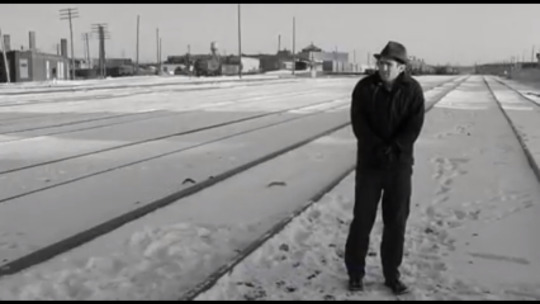
Jarmusch’s signature style came into fruition in his first feature, Stranger Than Paradise (1984). An example of a signature micro technique Jarmusch uses in the film is black and white cinematography. The black and white colours create a sense of similarity between locations, in order to create a feeling that the characters are lost in a country where all locations seem to have a uniform lack of emotion. This can also be seen in the dialogue, such as when Willie remarks “It’s the same Chesterfields, all over America”, and when Eddie states “You know, it’s funny. You come to someplace new, and everything looks just the same”. Jarmusch would go on to use this monochrome filter in his films Down By Law (1986) and Dead Man (1995), other pictures that display outsiders losing themselves in a black and white conformist America. This is a common motif in Jarmusch films and demonstrates how Jarmusch subverts the ideological conventions of genre outlined by Robin Wood (1977). Jarmusch subverts the ideological conventions of American Capitalism, specifically ‘America as the land where everyone is or can be happy’, by presenting the audience with an America of lost outsiders who are searching for the happiness promised to them, and ultimately just finding more of the same.

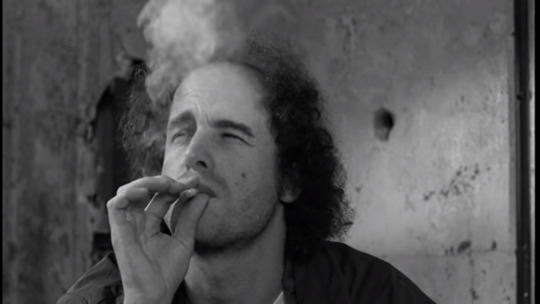

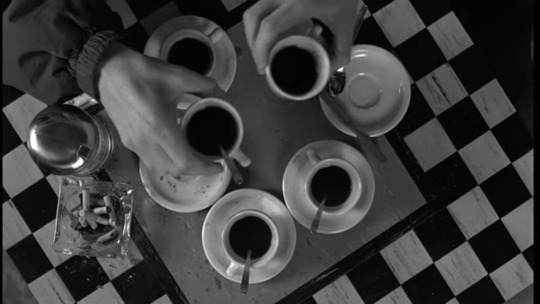
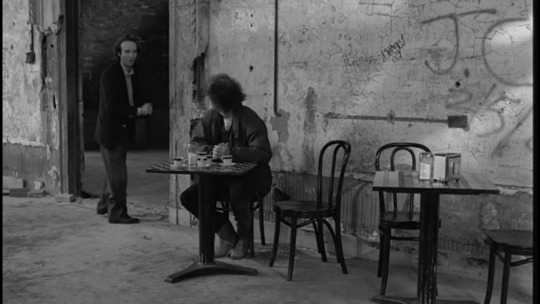
Jarmusch’s consistency of style can be seen in his collection of vignettes, Coffee and Cigarettes (2003). Jarmusch’s collection all have a standardised technique which creates a consistent style, which stylistically links the vignettes. The vignettes all use the same shots: a wide shot, a two shot, two one shots, and an overhead shot. In terms of shot syntax theses shots are not necessarily in the same order, however they have the same technical use, such as overhead shot being used to edit dialogue and the wide shot establishing the location. The use of this standardised procedure makes the vignettes instantly recognisable as part of the collection.


In Only Lovers Left Alive (2014) Jarmusch explores the vampire genre, however he actively avoids the genre’s stylistic conventions. This can be seen in the film’s final scene, and evidently it’s final shot. Adam and Eve go to attack their victims, and the shot is edited to slow motion as they approach. As they approach, the film’s score, which Jarmusch himself wrote with his band SQURL, is calming, instead of suspenseful. The sound is completely opposite to the generic sounds of horror, Jarmusch uses contrapuntal sound to subvert genre expectations. Finally, as Adam and Eve bare their fangs in order to attack their victims, the shot cuts and the credits roll. The action of the vampire genre comes from the scenes in which they attack their victims, however as this is a Jarmusch movie the focus is not on the action, but the meditative nature of the vampires stalking their prey.
However, there are some critics who would argue that Jarmusch belongs to a group of postmodern American filmmakers, including Quentin Tarantino, The Coen Brothers, Spike Lee and David Lynch. Jarmusch is paired with these postmodern filmmakers as his filmography “presents us with stories that disrupt the clear unified and causal structure of Hollywood films”; and “breakup the generic structures, overthrowing the need for closure, one of the main characteristics of classic Hollywood.” (Petkovic, Vukovic, 2011). This attributes Jarmusch’s style to postmodernism and not his individual personality, disputing the idea that his style stems from his authorship. Countering this critical view, although Jarmusch’s films do have aspects of postmodern filmmaking, his style is too engraved into his individual influences and personality. Referring to Jarmusch’s style as ‘postmodern’ is a tenuous description as it ignores a lot of what is included in his stylistic vocabulary.
Jarmusch’s direction on these three films establish a distinct style that is recognisable and individualistic. Jarmusch’s ‘distinguishable personality’ (Grant and Sarris, 2008) is stamped onto his films through stylistic elements. This adds to the argument for Jarmusch’s authorship, as his films have a distinguishable style that is expressive of his personality, and that the audience can recognise as his.
What are the themes that Jarmusch consistently explores in his films?
Jarmusch’s films are all linked by running themes. These include such themes and motifs as foreign perspectives of American culture, outsiders, underground music, and existential crises. The inclusion of these themes show that Jarmusch is an auteur. Themes create meaning in film, they express the director’s thoughts. They contribute to what Andrew Sarris describes as “interior meaning” (Grant and Sarris, 2008), the director putting personal meaning into the film. A prominent theme that runs through Jarmusch’s movies is outsiders, and in terms of ideology Jarmusch is definitely ‘rooted in opposition to the ideology of the country in which it is produced’ (Wood, 1977). All of Jarmusch’s protagonists are somehow outsiders of their society, critic Simon Hattenstone describes Jarmusch’s characters as tending to be “losers, drifters and strays” (Hattenstone, 2004).

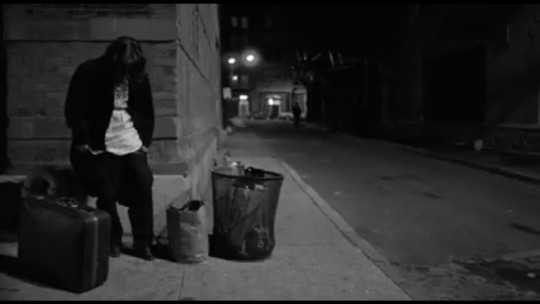
In Stranger Than Paradise (1984), Eva and Willie are outsiders to American society, their Hungarian roots making them inherently outsiders, as they live in a society which is foreign to them. However, instead of portraying this difference of these characters as negative, Jarmusch uses their outsider nature to celebrate individualism. This can be seen when Eva comments on the dress Willie has bought her to help her to conform to American society. In her dialogue Eva remarks “I think it’s kinda ugly, don’t you?” and “I don’t really wear this style”. Eva rejects the American culture as by conforming to it she will lose her ‘style’ and individualism. Through doing this she is rejecting an ideology in which ‘Subversive systems are assimilated wherever possible to serve the dominate ideology’ (Robin Wood, 1977) Compared to Eva, Willie has rejected his Hungarian roots, changing his name to fit in. Yet he is still an outsider and is much more lost than Eva. Willie gives the symbolic prop of the dress to Eva in order for her to join him in conformity, as he is alone. A few scenes before he gives her the dress, Willie is prominently playing solitaire in the foreground of the shot, a lonely game for a lonely character.

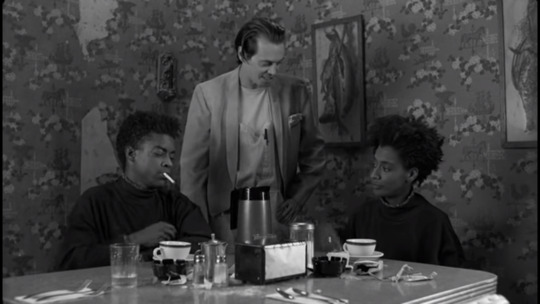
In Coffee and Cigarettes (2003) Jarmusch casts a range of counter cultural characters as outsider nicotine and caffeine addicts. Their behaviour is constantly questioned, such as in the piece of dialogue Jarmusch repeats in multiple of his vignettes, “Coffee and Cigarettes, that isn’t a very healthy lunch”. Their behaviour is seen as abnormal to the ‘normal’ character, who usually take the form of waiters such as in the vignettes ‘Renee’ and ‘Twins’.
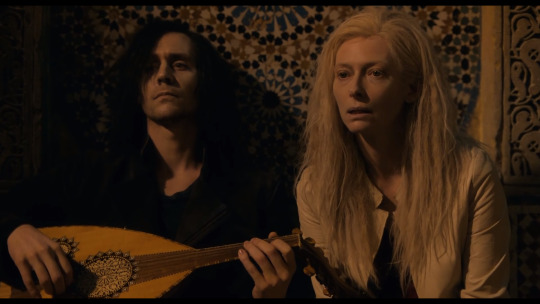
In Only Lovers Left Alive (2014) the characters are outcasts to the society of the humans, who they refer to as ‘Zombies’. This can be seen in the last scene, where the two ageless lovers look at the young couple with disdain. Swinton’s performance shows how the character of Eve views the couple as something she does not understand. The lovers then decide to use them as a means of survival, literally taking their life from them and using it so they can carry on living as immortal outsiders.
Jarmusch’s characters are outsiders who are not dictated by the rules of their society. This theme is present in all of Jarmusch’s movies, regardless of the genre or concept, Jarmusch is able to make an outsider of any character, be it a bohemian, cigarette smoker, or vampire, and he is able to create meaning with his themes. The inclusion of the outsider, along with a multitude of other identifiable themes, in Jarmusch’s films show how Jarmusch is able to place his personality within the DNA of his films. Sarris claimed that ‘The way a film looks and moves should have some relationship to the way a director thinks and feels’ (Grant and Sarris, 2008), and Jarmusch is able to place the theme of the outsider into his movies possibly in order to reflect his own feelings of being an outsider, as he is himself an independent filmmaker and part of an underground, outsider culture. Jarmusch himself outlines his alienation with American culture and demonstrates his own feelings as an outsider by describing his films as a ‘reaction to things being glossy and quick cut’ (Keogh, 1992). Jarmusch references how his films subvert mainstream American media, and consequently subvert American ideology. Through thematic devices Jarmusch is able to reflect his ideals, his culture, his experiences and even his musical tastes in his films. This helps prove that Jarmusch has full authorship, as his personality is part of his films.
Can Jarmusch be considered the auteur of his films despite his collaborations?
Jarmusch works with a multitude of culturally significant collaborators, such as actors whose individual personalities influence his films. In terms of the argument that Jarmusch’s collaborators partly have a claim to the authorship of his filmography, the actors in his movies are the collaborators with the largest influence over his films. Jarmusch’s films are heavily dependent on the characters and subsequently the actors who play them. Although Jarmusch creates the characters and writes the dialogues, actors often improvise their lines. In relation to Star Theory (Gledhill,1990) Jarmusch is also aided by his actor’s star power, he usually casts recognisable actors with existing acclaim and fan bases. This in turn contributes to the success of his movies as audience can expected high quality performances from Jarmusch’s films. Jarmusch himself describes the influence of his actors, stating “Usually I write for specific actors and have an idea of a character. I want to collaborate with them on. The story is suggested by those characters.” (Keogh, 1992)
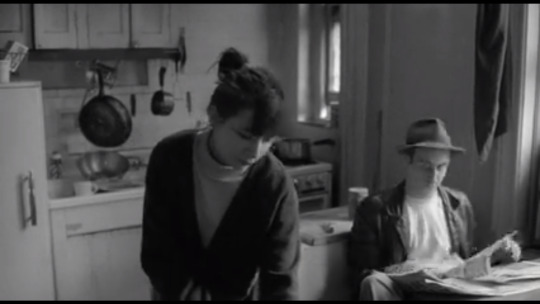


Meaning in Stranger Than Paradise (1984) is mainly shaped by Willie and his interactions with American culture, Eva and Eddie. Willie is played by John Lurie, a Jazz musician who also wrote the score for the film. A lot of the film’s droning feel relies on the score, often faded into in the cuts to black in between scenes and is abruptly stopped before the next cut. Lurie also appears in Jarmusch’s films that preceded Stranger Than Paradise (1984), Permanent Vacation (1980), and the film that proceeded it, Down By Law (1986).

In Coffee and Cigarettes (2003) the actors often play fictionalised versions of themselves, the characters are based on exaggerated versions of the actors’ personality. This adds to the collection’s meaning as a lot of the humour relies on the context of the actors, such as the ridiculousness of actor Bill Murray drinking too much coffee and going off the grid in ‘Delirium’. Improvisation was used frequently in the vignettes with these actors as they were practically playing themselves, and the use of the overhead shot allows Jarmusch to then edit the dialogue to fit with the improvisation. Murray in his later career has been known for making critically acclaimed independent films, such as Lost in Translation (2003) and Jarmusch’s film Broken Flowers (2005), at which point critic Michael brook points out ‘he was by far the biggest star to appear in a Jarmusch film’ (Michael Brooke,2015). Murray’s association with successful independent films may contribute to the success of the Jarmusch films he stars in as he has ‘Capital Value’ (Gledhill, 1990) in relation to independent films.

In Only Lovers Left Alive (2014), the film is heavily reliant on the two lead’s performances, and a lot of the films meaning comes from these performances. Hiddleston and Swinton’s performances influence the film immensely. A lot of meaning is created in the film by the contrast between the characters of Adam and Eve. The effect of the actors’ performances is apparent in their body language, in the final scene the actors lean on each other as they are dying together, reflecting how they both rely on each other. Their ability to create meaning through performance shows their strong influence over the film. Both actors are big names who have had multiple acclaimed performances. This may have influenced the success of the movie as audience members will have had positive expectations in relation to the performances in the film.
Jarmusch’s movies often rely on the context, performance and personality of the actors. This means that the actors have some claim to authorship as they have noticeable influence over the film. Furthermore, due to the statuses of Jarmusch’s actors, they have influence as they are able to use their ‘capital value’ (Gledhill, 1990) as culturally significant and critically acclaimed actors to contribute to the success of Jarmusch’s movies.
Collaborations are an integral part of Jarmusch’s filmography and are a convincing counterargument to him being the ‘true author’. However, aside from argument of the strong influence of actors, Jarmusch does seem to have control over the other aspects of his filmmaking. A notable aspect is writing, Jarmusch writes all of his movies. This gives him a stronger claim to authorship as he is able to create a world within the script and then transfer it to the medium of film, overseeing the process the entire way. Furthermore parts of star theory (Gledhill, 1990) could be considered irrelevant in relation to arguing against Jarmusch’s authorship, for example ‘capital value’ only contributing to the success of a film and not the actual content of the film. Film is claimed to be a collaborative medium, but Jarmusch has such control over his films that authorship could not be claimed by anyone else.
Evaluation of Research
I think I have found sufficient evidence to support the claim that Jim Jarmusch is the Auteur of his films. Jarmusch is able to successfully fulfil all three premises of Sarris’ auteur theory: ‘technique’, ‘personal style’, and ‘interior meaning’. Looking at Jarmusch through this theoretical perspective made the arguments for and against Jarmusch’s authorship much clearer, and if I was to revise my research I would focus more on theoretical perspectives as they were essential in evaluating my analysis of Jarmusch’s work. In terms of my research I think I found a lot of evidence, just through evaluating critical perspectives of Jarmusch’s career alone I was able create a vivid picture of Jarmusch’s authorship. However, I could have used more theoretical perspectives as these proved the most useful in evaluating my analysis of Jarmusch’s work. I think the three focal films I focused on were appropriated as allowed me to analyse Jarmusch’s work across stages of his career, with the chronology of each films release being 1984, 2003, and 2014. Coffee and Cigarettes (2003) was the focal film I found most useful due to the fact that each vignette was filmed at different stages of Jarmusch’s career, allowing me to view which elements of his style had changed and which elements were consistent throughout his work.
Unannotated Sources
1. Stranger Than Paradise. (1984). [film] Directed by J. Jarmusch. USA: Cinesthesia Productions, Grokenberger Film Produktion, Zweites Deutsches Fernsehen (ZDF).
2. Coffee and Cigarettes. (2003). [film] Directed by J. Jarmusch. USA: Asmik Ace Entertainment, BIM Distribuzione, Smokescreen Inc.
3. Only Lovers Left Alive. (2013). [film] Directed by J. Jarmusch.USA. Recorded Picture Company (RPC), Pandora Filmproduktion, Snow Wolf Produktion.
4. Pinkerton, N. (2014). Interview: Jim Jarmusch. Sight and Sound, (Volume 24 Issue 3), pp.50-56.
5. Hattenstone, S. (2004). A Talk On The Wild Side. The Guardian Website. [online] Available at: https://www.theguardian.com/film/2004/nov/13/features.weekend[Accessed 1 Oct. 2017].
6. A, G. (1999). Guardian Interviews at the BFI. The Guardian Website, [online] pp.1-4. Available at: https://www.theguardian.com/film/series/guardian-interviews-at-the-bfi?page=8 [Accessed 1 Oct. 2017].
7. Evans, G. (2017). All About Jim Jarmusch’s Leading Men. BFI Website. [online] Available at: http://www.bfi.org.uk/news-opinion/news-bfi/lists/jim-jarmusch-leading-actors-tom-waits-bill-murray [Accessed 11 Oct. 2017].
8. Andrew, G. (2015). Why ‘cool’ doesn’t do Jim Jarmusch justice. BFI Website. [online] Available at: http://www.bfi.org.uk/news-opinion/news-bfi/features/why-cool-doesnt-jim-jarmusch-justice [Accessed 12 Oct. 2017].
9. Keogh, P. (2017) Jim Jarmusch: Home and Away. (2017). Sight and Sound, (4), pp.8-9.
10. Keogh, P. (2014). Jim Jarmusch: Hoe the film world’s maverick stayed true to his roots. Sight and Sound. [online] Available at: https://www.theguardian.com/film/2014/feb/22/jim-jarmusch-only-lovers-left-alive [Accessed 16 Oct. 2017].
11. Jim Jarmusch: Women are my leaders’. (2014). The Guardian Website. [online] Available at: https://www.theguardian.com/film/2014/feb/20/jim-jarmusch-women-leaders-only-lovers-left-alive [Accessed 16 Oct. 2017].
12. Grant, B. and Sarris, A. (2008). Auteurs and authorship. Oxford: Blackwell, pp.561-564.
13. Petković, R. and Vuković, K. (2011). Postmodern Philosophy and the Impact of the Other in Jim Jarmusch’s Films. [sic] - a journal of literature, culture and literary translation, (2.1).
14. Jenny McDonell, J. (2014). Only Lovers Left Alive. The Irish Journal of Gothic and Horror Studies, 13, pp.127-129.
15. Glbey, R. (2017). How Jim Jarmusch used music to put a spell on Hollywood. The Guardian Website. [online] Available at: https://www.theguardian.com/music/2017/sep/21/jim-jarmusch-revisited-hollywood-film-soundtracks [Accessed 22 Oct. 2017].
16. Dyer, R. (1992). Only entertainment. London u.a.: Routledge.
17. Gledhill, C. (1990). Guide to the stars. New York: Routledge.
18. Wood, R (1977) Ideology, Genre, Auteur. Pp.1.16.18 from Film Comment 13, no. 1 (January-February 1977)
19. Brooke, M. (2015). A-list meets arthouse: when megastar actors work for auteurs. BFI. [online] Available at: http://www.bfi.org.uk/news-opinion/news-bfi/lists/list-meets-arthouse-when-megastar-actors-work-auteurs [Accessed 28 Jan. 2018].
20. Lost in Translation. (2003). [film] Directed by S. Coppola. Focus Featuresm, TFC, American Zoetrope, Elemental Films.
21. Broken flowers. (2005). [film] Directed by J. Jarmusch. USA: Focus Features, Five Roses, Bac Films.
22. Permanent Vacation. (1980). [film] Directed by J. Jarmusch. USA: Cinesthesia Productions.
23. Down By Law. (1986). [film] Directed by J. Jarmusch. USA: Black Snake, Grokenberger Film Produktion, Island Pictures.
0 notes
Text
Post T. Creative Investigation First Draft
Joe Simpson Creative Investigation
Auteur theory was first introduced, by the cahiers de cinema critics such as Andre Bazin and Alexandra Astruc, as a way to distinguish the filmmaker as an author/auteur. French filmmaker Francois Triffaut coined the term ‘’la politique des auteurs’’ in ‘Une Certaine Tendance du Cinema Francais’, arguing that auteurs have a distinctive style established by consistent themes and ideas. The theory has been adopted by many critics, included American Andrew Sarris who, in Notes on auteur theory in 1962, established three circular premises of auteur theory: ‘the outer circle as technique; the middle circle, personal style; and the inner circle, interior meaning’ (Sarris, Keith Grant, 2008) .
I have studied the filmmaker Jim Jarmusch, and in my creative investigation I will attempt to answer whether Jarmusch can claim full authorship of his films. The subtopics I will look at are distinguishable style, consistent themes and the influence of collaborators. I will use auteur theory, mainly Andrew Sarris’ premises of auteur theory, and analysis of Jarmusch’s filmography to explore Jarmusch’s claim to authorship.
Does Jarmusch have a recognisable style, which distinguishes his movies as authored by him?
As part of my auteur study of Jim Jarmusch I have analysed the films Stranger than Paradise (1984), Coffee and Cigarettes (2003), and Only Lovers Left Alive (2014). I have analysed the stylistic elements of these movies in order to establish Jarmusch signature style, and to establish that this style makes his filmography distinguishable as a Jim Jarmusch film. According to film theorist Andrew Sarris, stylistic characteristics are important to establish a filmmaker as an auteur. A director’s film must be distinguishable and “must exhibit certain recurrent characteristics of style, which serve as his signature” (Grant and Sarris, 2008). Jarmusch’s films definitely have an individual style. They are minimalist, experimental, and reserved, yet also deeply emotional. Jarmusch’s style is his own. As critic Jonathan Romney states, “Jarmusch can’t be easily pinned down to any cinematic wave or category” (Romney, 2014). In every film Jarmusch stamps his personality onto it, through such things as referencing his influences and conveying his ideas through his characters’ subtly philosophical dialogue.
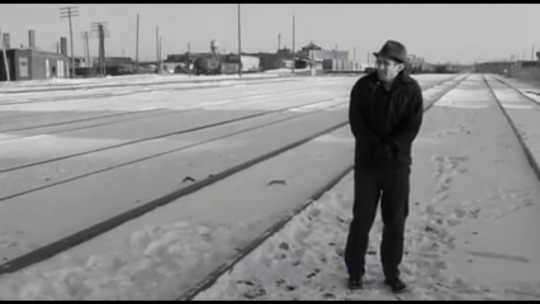
Jarmusch’s signature style first came into fruition in his first feature, Stranger Than Paradise (1984). An example of a signature micro technique Jarmusch uses in the film is black and white cinematography. The black and white colours create a sense of similarity between locations, in order to create a feeling that the characters are lost in a country where all locations seem to have a uniform lack of emotion. This can also be seen in the dialogue, such as when Willie remarks “It’s the same Chesterfields, all over America”, and when Eddie states “You know, it’s funny. You come to someplace new, and everything looks just the same”. Jarmusch would go on to use this monochrome filter in his films Down By Law (1986) and Dead Man (1995), other pictures that display outsiders losing themselves in a black and white conformist America.
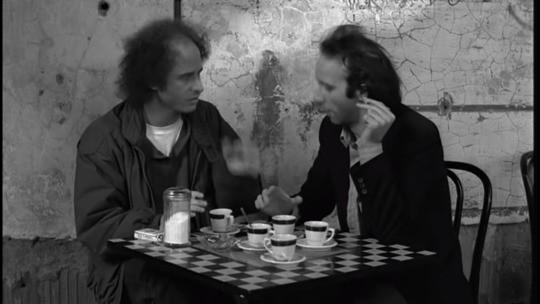

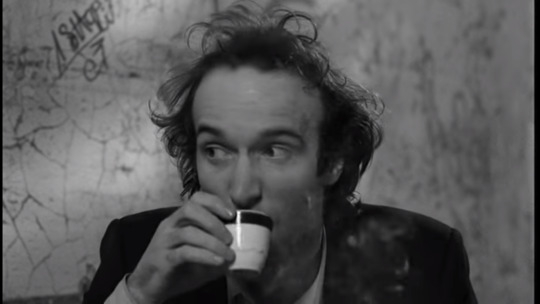
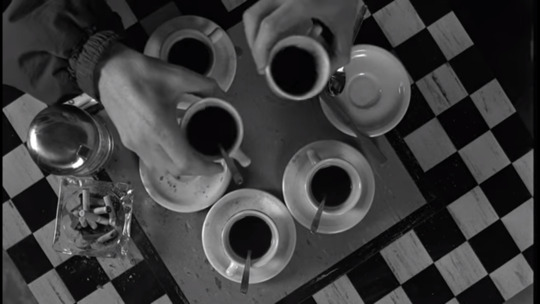
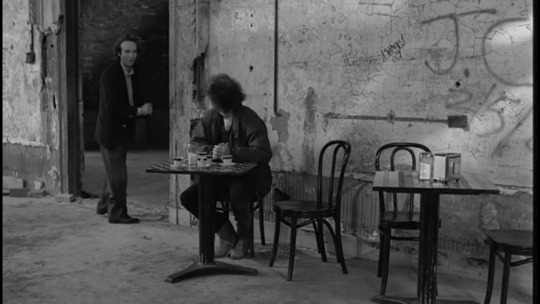
Jarmusch’s consistency of style can be seen in his collection of vignettes, Coffee and Cigarettes (2003). Jarmusch’s collection all have a standardised technique which creates a consistent style, which stylistically links the vignettes. The vignettes all use the same shots: a wide shot, a two shot, two one shots, and an overhead shot. In terms of shot syntax theses shots are not necessarily in the same order, however they have the same technical use, such as overhead shot being used to edit dialogue and the wide shot establishing the location. The use of this standardised procedure makes the vignettes intently recognisable as part of the collection.
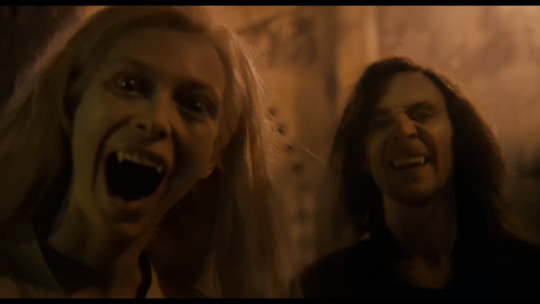
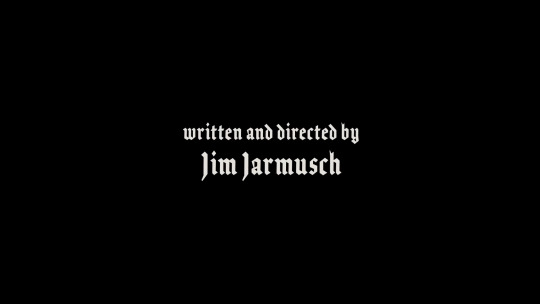
In Only Lovers Left Alive (2014) Jarmusch explores the vampire genre, however he actively avoids the genre’s stylistic conventions. This can be seen in the film’s final scene, and evidently it’s final shot. Adam and Eve go to attack there victims, and the shot is edited to slow motion as they approach. As they approach, the film’s score, which Jarmusch himself wrote with his band SQURL, is calming, instead of suspenseful. The sound is completely opposite to the generic sounds of horror. Finally, as Adam and Eve bare their fangs in order to attack their victims, the shot cuts and the credits roll. The action of the vampire genre comes from the scenes in which they attack their victims, however as this is a Jarmusch movie the focus is not on the action, but the calming nature of the vampires stalking their prey.
However, there are some critics who would argue that Jarmusch belongs to a group of postmodern American filmmakers, including Quentin Tarantino, The Coen Brothers, Spike Lee and David Lynch. Jarmusch is paired with these postmodern filmmakers as his filmography “presents us with stories that disrupt the clear unified and causal structure of Hollywood films”; and “breakup the generic structures, overthrowing the need for closure, one of the main characteristics of classic Hollywood.” (Petkovic, Vukovic). This attributes Jarmusch’s style to postmodernism and not his individual personality, disputing the idea that his style stems from his authorship. Countering this critical view, although Jarmusch’s films do have aspects of postmodern filmmaking, his style is too engraved into his individual influences and personality. To referring to Jarmusch’s style as ‘postmodern’ is a tenuous description as it ignores a lot of what is included in his stylistic vocabulary.
Jarmusch’s direction on these three films establish a distinct style that is recognisable and individualistic. This adds to the argument for Jarmusch’s authorship, as his films have a style that is expressive of his personality, and that the audience can recognise as his.
What are the themes that Jarmusch consistently explores in his films?
Jarmusch’s films are all linked by running themes. These include such themes and motifs as foreign perspectives of American culture, outsiders, underground music, and existential crises. The inclusion of these themes show that Jarmusch is an auteur, as he is able to include running thematic devices in his theme that create a personal meaning in his filmography. Themes create meaning in film, they express the director’s thoughts. They contribute to what Andrew Sarris describes as “interior meaning” (Grant and Sarris, 2008), the director putting personal meaning into the film. A prominent theme that runs through Jarmusch’s movies is outsiders. All of Jarmusch’s protagonist are somehow outsiders of their society, critic Simon Hattenstone describes Jarmusch’s characters as tending to be “losers, drifters and strays” (Hattenstone, 2004).
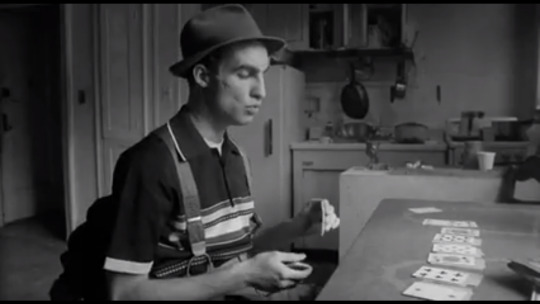
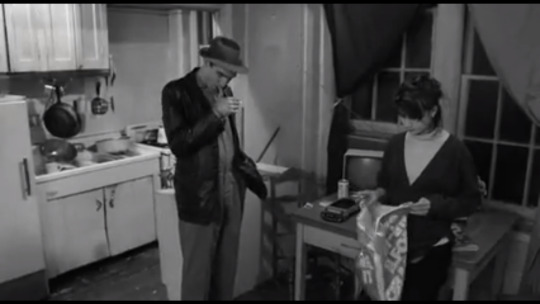
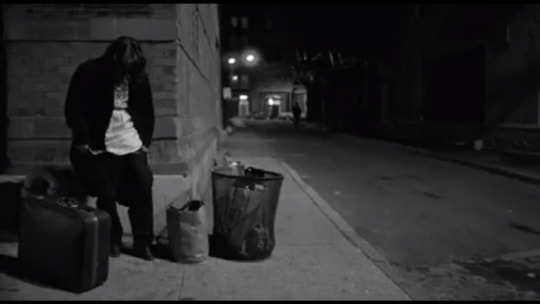
In Stranger Than Paradise (1984), Eva and Willie are outsiders to American society, their Hungarian roots making them inherently foreign to the society. However instead of portraying this difference of the characters as negative, Jarmusch uses their outsider nature to celebrate individualism. This can be seen when Eva comments on the dress Willie has bought her to help her to conform to American society. In her dialogue Eva remarks “I think it’s kinda ugly, don’t you?” and “I don’t really wear this style”. Eva rejects the American culture as by conforming to it she will lose her ‘style’ and individualism. Compared to Eva, Willie has rejected his Hungarian roots, changing his name to fit in. Yet he is still an outsider and is much more lost than Eva. Willie gives the symbolic prop of the dress to Eva in order for her to join him and conformity, as he is alone. A few scenes before he gives her the dress, Willie is prominently playing solitaire in the foreground of the shot, a lonely game for a lonely character.
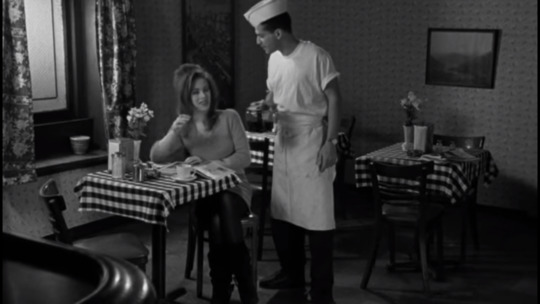

In Coffee and Cigarettes (2003) Jarmusch casts a range of counter cultural characters as outsider nicotine and caffeine addicts. Their behaviour is constantly questioned, such as in the piece of dialogue Jarmusch repeats in multiple of his vignettes, “Coffee and Cigarettes, that isn’t a very healthy lunch”. Their behaviour is seen as abnormal to the ‘normal’ character, who usually take the form of waiters such as in the vignettes ‘Renee’ and ‘Twins’.
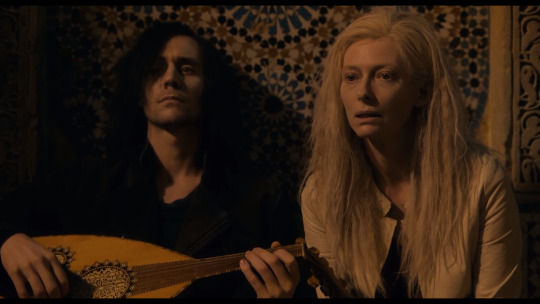
In Only Lovers Left Alive (2014) the characters are outcasts to the society of the humans, who they refer to as ‘Zombies’. This can be seen in the last scene, where the two ageless lovers look at the young couple with disdain. Swinton’s performance shows how the character of Eve views the couple as something she does not understanding. The lovers then decide to use them as a means of survival, literally taking their life from them and using it so they can carry on living as immortal outsiders.
Jarmusch’s characters are outsiders who are not dictated by the rules of their society. This theme is present in all of Jarmusch’s movies, regardless of the genre or concept, Jarmusch is able to make an outsider of any character, be it a bohemian, cigarette smoker, or vampire, and he is able to create meaning with his themes. The inclusion of the outsider, along with a multitude of other identifiable themes, in Jarmusch’s films show how Jarmusch is able to place his personality within the DNA of his films. Through thematic devices Jarmusch is able to reflect his ideals, his culture, his experiences and even his musical tastes in his films. This helps prove that Jarmusch has full authorship, as his personality is part of his films.
Can Jarmusch be considered the auteur of his films despite his collaborations?
Jarmusch works with a multitude of culturally significant collaborators, such as actors whose individual personalities influence his films. In terms of the argument that Jarmusch’s collaborators partly have a claim to the authorship of his filmography, the actors in his movies are the collaborators with the largest influence over his films. Jarmusch’s films are heavily dependent on the characters and subsequently the actors who play them. Although Jarmusch creates the characters and writes the dialogues, actors often improvise their lines. Jarmusch himself describes the influence of his actors, stating “Usually I write for specific actors and have an idea of a character. I want to collaborate with them on. The story is suggested by those characters.” (Keogh, 1992)
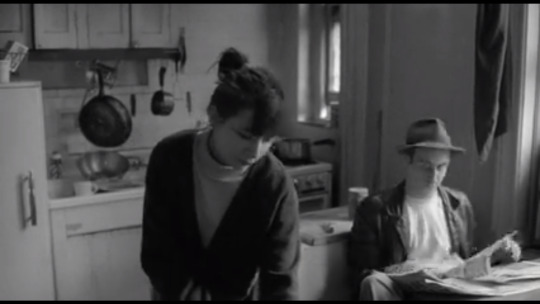


Stranger Than Paradise’s meaning is mainly shaped by Willie and his interactions with American culture, Eva and Eddie. Willie is played by John Lurie, a Jazz musician who also wrote the score for the film. A lot pf the films droning feel relies on the score, often faded into in the cuts to black in between scenes and is abruptly stopped before the next cut. Lurie also appears in Jarmusch’s films that preceded Stranger Than Paradise (1984), Permanent Vacation (1980), and the film that proceeded it, Down By Law (1986).
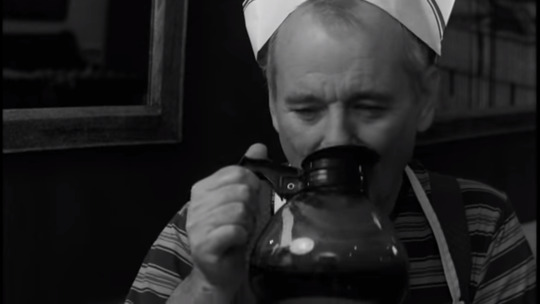
In Coffee and Cigarettes the actors often play fictionalised versions of themselves, the characters are based on exaggerated versions of the actors’ personality. This adds to the collection’s meaning as a lot of the humour relies on the context of the actors, such as the ridiculousness of actor Bill Murray drinking too much coffee and going off the grid in ‘Delirium’. Improvisation was used frequently in the vignettes with these actors as they were practically playing themselves, and the use of the overhead shot allows Jarmusch to then edit the dialogue to fit with the improvisation.
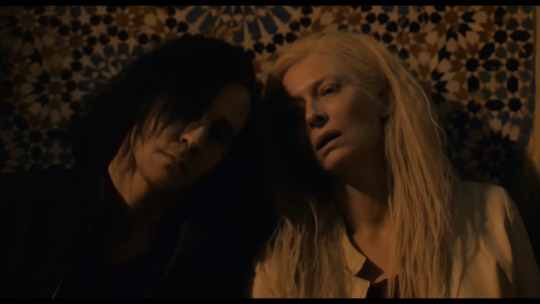
The film is heavily reliant on the two lead’s performances, and a lot of the films meaning comes from these performances. Hiddleston and Swinton’s performances influence the film immensely. A lot of meaning is created in the film by the contrast between the characters of Adam and Eve. The effect of the actors’ performances is apparent in their body language, in the final scene the actors lean on each other as they are dying together, reflecting how they both rely on each other. Their ability to create meaning through performance shows their strong influence over the film.
Jarmusch’s movies often rely on the context, performance and personality of the actors. This means that the actors have some claim to authorship as they have noticeable influence over the film. Collaborations are an integral part of Jarmusch’s filmography and are a convincing counterargument to him being the ‘true author’.
Aside from argument of the strong influence of actors, Jarmusch does seem to have control over the other aspects of his filmmaking. A notable aspect if writing, Jarmusch writes all of his movies. This gives him a stronger claim to authorship as he is able to create a world within the script and then transfer it to the medium of film, overseeing the process the entire way.
Conclusion
To conclude, it appears that Jarmusch definitely has claim to full authorship of his films. His personality is distinguishable through his films, be it through stylistic individuality or thematic links. Jarmusch is able to employ these links to create a personal meaning through his entire filmography. Although there are arguments that dispute Jarmusch’s, such as the influence of collaborators, Jarmusch has such control over the production of his films it is more accurate to claim that it is he who influences his cast and crew. Film is claimed to be a collaborative medium, but Jarmusch has such control over his films that authorship could not be claimed by anyone else. He is the auteur.
0 notes
Text
Post S. Essay Abstract
Hypothesis:
Jarmusch can claim to have full authorship of his films
Style:
Is Jarmusch’s films stylistically individual or belonging to a movement?
Themes:
What are the themes that Jarmusch consistently explores in his films?
Collaborations:
How much claim do Jarmusch’s collaborators have to authorship of his films?
Style:
Intro: As part of my auteur study of Jim Jarmusch I have analysed the films Stranger than Paradise (1984), Coffee and Cigarettes (2003), and Only Lovers Left Alive (2014). I have analysed the stylistic elements of these movies in order to establish Jarmusch’s signature style.
Point: According to film theorist Andrew Sarris, stylistic characteristics are important to establish a filmmaker as an auteur. A directors film must be distinguishable and “must exhibit certain recurrent characteristics of style, which serve as his signature” (Grant and Sarris, 2008).
Source: Jarmusch’s films definitely have an individual style. They are minimalist, experimental, and reserved, yet also deeply emotional. Jarmusch’s style is his own. As critic Jonathan Romney states, “Jarmusch can’t be easily pinned down to any cinematic wave or category” (Romney, 2014) . In every film Jarmusch stamps his personality onto it, through such things as referencing his influences and conveying his ideas through his characters’ subtly philosophical dialogue.
Evidence 1: Jarmusch’s signature style first came into fruition in his first feature, Stranger Than Paradise (1984). An example of a signature micro technique Jarmusch uses in the film is black and white cinematography. The black and white colours create a sense of similarity between locations, in order to create a feeling that the characters are lost in a country where all locations seem to have a uniform dullness. This can also be seen in the dialogue, such as when Willie remarks “It’s the same Chesterfields, all over America”, and when Eddie states “You know, it’s funny. you come to someplace new, and everything looks just the same”. Jarmusch would go on to use this monochrome filter in his films Down By Law (1986) and Dead Man (1995), other pictures that display outsiders losing themselves in a black and white conformist America.
Evidence 2: Jarmusch’s consistency of style can be seen in his collection of vignettes, Coffee and Cigarettes (2003). Jarmusch’s collection all have a standardised technique which creates a consistent style, which stylistically links the vignettes. The vignettes all use the same shots: an establishing shot, a two shot, two one shots, and an overhead shot. The use of this standardised procedure makes the vignettes intently recognisable as part of the collection.
Evidence 3: In Only Lovers Left Alive (2014) Jarmusch explores the vampire genre, however he actively avoids the genre’s stylistic conventions. This can be scene in the films final scene, and evidently it’s final shot. Adam and Eve go to attack there victims, and the shot is edited to slow motion as they approach. As they approach, the film’s score, which Jarmusch himself wrote with his band SQURL, is calming, instead of suspenseful. The sound is completely opposite to the generic sounds of horror. Finally, as Adam and Eve bare their fangs in order to attack their victims, the shot cuts and the credits roll. The action of the vampire genre comes from the scenes in which they attack their victims, however as this is a Jarmusch movie the focus is not on the action, but the calming nature of the vampires stalking their prey.
Explain: Jarmusch’s direction on these three films establish a distinct style that is recognisable and individualistic. This adds to the argument for Jarmusch’s auteurism, as his films have a style that is expressive of his personality, and that the audience can recognise as his.
Evaluate: However, there are some critics who would argue that Jarmusch belongs to a group of postmodern American filmmakers...
Themes:
Intro: Jarmuch’s films are all linked by running themes. These include foreign perspectives of American culture, outsiders, obscure music, and existential crises.
Point: Themes create meaning in film, they express the directors thoughts. They contribute to what Andrew Sarris describes as “interior meaning” (Grant and Sarris, 2008), the director putting personal meaning into the film,
Source: A prominent theme that runs through Jarmusch’s movies is outsiders. All of Jarmusch’s protagonist are somehow outsiders of their society, critic Simon Hattenstone describes Jarmusch’s characters as tending to be “losers, drifters and strays” (Hattenstone, 2004).
Evidence 1: In Stranger Than Paradise (1984), Eva and Willie are outsiders to American society, their Hungarian roots making them inherently foreign to the society./ However instead of portraying this difference of the characters as negative, Jarmusch uses their outsider nature to celebrate individualism. This can be seen when Eva comments on the dress Willie has bought her to help her to conform to American society. In her dialogue Eva remarks “I think it’s kinda ugly, don’t you?” ,and “I don’t really wear this style”. Eva rejects the American culture as by conforming to it she will lose her ‘style’ and individualism. Compared to Eva, Willie has rejected his Hungarian roots, changing his name to fit in. Yet he is still an outsider and is much more lost than Eva. Willie gives the symbolic prop of the dress to Eva in order for her to join him and conformity, as he is alone. A few scenes before he gives her the dress, Willie is prominently playing solitaire in the foreground of the shot, a lonely game for a lonely character.
Evidence 2: In Coffee and Cigarettes (2003) Jarmusch casts a range of counter cultural as outsider nicotine and caffeine addicts. Their behaviour is constantly questioned, such as in the piece of dialogue Jarmusch repeats in multiple of his vignettes, “Coffee and Cigarettes, that isn’t a very healthy lunch”. Their behaviour is seen as abnormal to the ‘normal’ character, who usually take the form of waiters such as in the vignettes ‘Renee’ and ‘Twins’.
Evidence 3: Outsiders to human society, Swinton looking at them like prey
In Only Lovers Left Alive (2014) the characters are outcasts to the society of the humans, who they refer to as ‘Zombies’. This can be seen in the last scene, where the two ageless lovers look at the young couple with disdain. Swinton’s performance shows how the character of Eve views the couple as something she does not understanding. The lovers then decide to use them as a means of survival, literally taking their life from them and using it so they can carry on living as immortal outsiders.
Explain: Jarmusch’s characters are outsiders who are not dictated by the rules of their society. This theme is present in all of Jarmusch’s movies, regardless of the genre or concept, Jarmusch is able to make an outsider of any character, be it a bohemian, cigarette smoker, or vampire.
Evaluate: Another theme that links Jarmusch’s movies is Cigarettes...
Collaborations:
Intro: Jarmusch works with a multitude of culturally significant collaborators, such as actors whose individual personalities influence his films
Point: Jarmusch’s films are heavily dependent on the characters and subsequently the actors who play them. Although Jarmusch creates the characters and writes the dialogues, actors often improvise their lines.
Source: Jarmusch himself describes the influence of his actors, stating “Usually I write for specific actors and have an idea of a character. I want to collaborate with them on. The story is suggested by those characters.” (Keogh, 1992)
Evidence 1: Stranger Than Paradise’s meaning is mainly shaped by Willie and his interactions with American culture, Eva and Eddie. Willie is played by John Lurie, a Jazz musician who also wrote the score for the film. A lot pf the films droning feel relies on the score, often faded into in the cuts to black in between scenes and is abruptly stopped before the next cut. Lurie also appears in Jarmusch’s films that preceded Stranger Than Paradise(1984), Permanent Vacation (1980), and the film that proceeded it, Down By Law (1986).
Evidence 2: In Coffee and Cigarettes the actors often play fictionalised versions of themselves, the characters are based on a exaggerated versions of the actors’ personality. This adds to the collection’s meaning as a lot of the humour relies on the context of the actors, such as the ridiculousness of actor Bill Murray drinking too much coffee and going off the grid in ‘Delirium’. Improvisation was used frequently in the vignettes with these actors as they were practically playing themselves, and the use of the overhead shot allows Jarmusch to then edit the dialogue to fit with the improvisation.
Evidence 3: The film is heavily reliant on the two lead. Hiddleston and Swinton’s performances influence the film immensely. A lot of meaning is created in the film by the contrast between the characters of Adam and Eve. The effect of the actors’ performances is apparent in their body language, in the final scene the actors lean on each other as they are dying together, reflecting how they both rely on each other.
Explain: Jarmusch’s movies often rely on the context, performance and personality of the actors. This means that the actors have some claim to authorship as they have noticeable influence over the film.
Evaluate: Jarmusch is also influenced by the cinematographers he works with...
0 notes
Text
Post R. Collated Quotes
Style:
Jim Jarmusch: “A career overview? I’m not a ‘big looking’ back guy, but I’ll do my best. I don’t even watch my films. Once I’m done with them they’re gone for me.” (Post E)
GA: “ It is entirely made up of discreet shots - every scene consists of one shot interrupted by black film - which is quite a formal or experimental way of telling the story. Why did you decide to do it and what is your interest in those formal things?’’ Jim Jarmusch: “I think it comes from really liking literary forms.” (Post G)
Jim Jarmusch: “The intention was to shoot short films that can exist as shorts independently, but when I put them all together, there are things that echo through them like the dialogue repeats; the situation is always the same, the way they’re shot is very simple and the same - I have a master shot, if there’s two characters, a two shot, singles on each, and an over-the-table overhead shot which I can use to edit their dialogue.So they’re very simple and because the design of how they’re shot is worked out already, it gives complete freedom to play; they’re like cartoons almost to me. And it’s a relief from making a feature film where everything has to be more carefully mapped out. So I like doing them and they’re ridiculous and the actors can improvise a lot, and they don’t have to be really realistic characters that hit a very specific tone as in a feature film. They’re really fun, I want to make more of them definitely. Sometime I will release them all together, but I don’t know when.’’ (Post G)
“I’m talking about a very particular, all too common response to his work – usually from fans, though also in some cases from detractors. It’s the notion that the main thing to say – indeed, perhaps the only thing to say – about Jarmusch and his films is that they are ‘cool’.” (Post I)
Peter Keogh “ You’re often referred to as a minimalist. Do you agree with that label?”Jim Jarmusch: “I think of minimalist as a label stuck on certain visual artists. But I don’t really feel associated with them.”Peter Keogh: “There are also literary minimalists - Raymond Carver, Anne Beaty”Jim Jarmusch: “I think maybe what they’re saying is that the films are very light on plot and therefore minimal stylistically as well. My style is certainly not Byzantine or florid or elaborate. It’s pretty simple. Reduced.” (Post J)
“Jarmusch can’t be easily pinned down to any cinematic wave or category. “I don’t know where I fit in. I don’t feel tied to my time.”He is certainly not on the same time scheme as the rest of cinema, or indeed, the rest of humanity – which is perhaps why Only Lovers Left Alive is one of several of his films, including Night on Earth and Mystery Train, to take place after dark. Tilda Swinton has said: “Jim is pretty much nocturnal, so the nightscape is pretty much his palette. There’s something about things glowing in the darkness that feels to me really Jim Jarmusch. He’s a rock star.” (Post K)
“As a director, too, there are recurring elements: a minimalist aesthetic, laconic but lovable characters (often played by musicians), a cool compositional remove that invites humour without sacrificing sincerity.” (Post L)
“The second premise of auteur theory is the distinguishable personality of the director as a criterion of value. Over a group of films, a director must exhibit certain recurrent characteristics of style, which serve as his signature. The way a film looks and moves should have some relationship to the way a director thinks and feels.” (Post M)
“…postmodernism reevaluates tradition and openly plays with its rich heritage, often in the form of pastiche.” (Post N)
“…modern American independent film,with Jarmusch as one of its leading representatives, presents us with stories that disrupt the clear unified and causal structure of Hollywood films, thus resembling the pattern of Lyotard’s “little narratives” . While Hollywood films fall into specific genres and strictly adhere to its conventions, the leading representatives of the modern American independent cinema (Jarmusch, Hal Hartley, Quentin Tarantino, the Coen brothers, David Lynch) breakup the generic structures, overthrowing the need for closure, one of the main characteristics of classic Hollywood. The temporal structure is distorted, as can be seen in Mystery Train or Pulp Fiction, while the focus of the films is not on the active, goal-oriented protagonist, but on the people from the fringes of society, outsiders who oppose the accepted social norms.” (Post N)
“The underlying tendency of Hollywood films is to present the world as ultimately presentable and knowable, but a more thorough analysis reveals the realism as only partly rooted and clearly distorting external reality. Mark Cousins labels the Hollywood style closed romantic realism, emphasizing the fact that actors seem to live in a parallel universe (494). Emotions are heightened, main characters idealized and able to over come any obstacle. Although presenting a parallel universe, Hollywood tries to create an illusion that the events shown on the screen correspond to the world around us, thus creating a falsified reality.” (Post N)
“Foucault’s and Baudrillard’s analyses are even more detailed, providing the useful concepts of hyperrealism and simulation. Illustrating his concept of the third-order image, Foucault claims that “Disney land is presented as imaginary in order to make us believe that the rest is real, when in fact all of Los Angeles and the America surrounding it are no longer real, but of the order of the hyperreal” (Post N)
“The concept of time has similarly been disrupted. Hollywood has always concentrated on kairos, the significant time, while completely abandoning the presentation of chronos, the ordinary time. The difference between these two concepts summarizes the inherent difference between Hollywood and the modern American independent film. While Hollywood has concentrated on action and dramatic aspects of storytelling, modern American independent films have explored the moments in-between, the events devoid of dramatic tension, which explains why Jarmusch chose not to present the most dramatic element in Down by Law, when the three cellmates escaped from prison.” (Post N)
“His second feature Stranger than Paradise, gloriously shot by Tom DiCillo in black and white cinematography, is divided into three parts and separated by fade-outs, whose function is to destroy the illusory nature of the Hollywood invisible style.The post-industrial and scapes of modern America are similar to those in Tarr’s Satantango , providing an anticipatory cultural link. The main protagonists come from Europe, which plays a vital role in many Jarmusch’s films, signifying the impact of the Other.” (Post N)
“All of this transpires at a pace that may admittedly prove frustrating for some viewers, but for me Only Lovers Left Alive it as its best during such sequences; in fact, it enters far more problematic territory precisely when it deviates from this rhythm.” (Post O)
“It also points to another significant aspect of the film, which is its use of music; this includes original contributions from Jarmusch’s own band SQÜRL, and a diverse list of other artists and tracks (including Charlie Feathers’s rockabilly classic ‘Can’t Hardly Stand It’). The music within the film functions as a soundtrack to persistent musings about the nature of art and the artist, and their resilience (or otherwise) with the passing of time” (Post O)
“In the end, Only Lovers Left Alive is exactly what you’d expect from a Jim Jarmusch vampire film: meditative and unhurried, wryly humorous and culturally allusive — and utterly beguiling. In fact, it turns out that the vampire makes for a curiously appropriate Jarmuschian figure, isolated and out-of-time. Its pair of undead lovers may have (quite literally) seen it all before, but they’ve ultimately provided a fresh take on the vampire genre.” (Post O)
Themes:
Jim Jarmusch: “Adam and Eve are sort of outside type characters, bohemian types, and they probably already were hundreds of years ago. They’re not exactly a representing the square world to start with. They’re kind of eternal. I hate the word ‘hipsters’, but they are certainly on the outsider’s side” (Post E)
“I guess most of my films are road movies’’ (Post E)
“His characters tend to be losers, drifters and strays.’’…’’His films are about communication, or crippled communication. People who love each other (or who will grow to love each other), but who can’t talk to each other. Often, foreigners can communicate more easily than fellow Americans, despite the language barrier.’’ (Post F)
“GA: The film has certainly got a serious side to it, but it is also very full of humour and that’s something that’s coursed through all of your work. Why is an element of comedy so important to you in your movies? JJ: Laughter is good for your spirit’’ (Post G)
“Nearly all of Jim Jarmusch’s 12 feature films to date are centred around a leading man, often playing a character in the midst of an existential crisis, whose sentiments and actions come to define the spirit of the movie.’’ (Post H)
“Now, it’s true that filmgoers hadn’t seen many movie protagonists like the slightly lazy, generally unremarkable Willie” (Post I)
“Time and again, Jarmusch seems to be telling us that love, friendship, respect for others, and an open, imaginative mind are key to answering that question.” (Post I)
“What fascinates Jarmusch in the vampire myth is less the usual blood-guzzling, though there’s plenty of that, than the educational opportunities afforded by supernaturally extended life.” (Post K)
“His films consistently flout the conventions of American screen storytelling. For one thing, their subjects are not always primarily American, and Jarmusch often shows the US from the perspective of foreign visitors: Italian, Hungarian, Japanese.” (Post K)
“The director’s seriousness is often underestimated, says New York critic and festival director Kent Jones: “There’s been an overemphasis on the hipness factor – and a lack of emphasis on his incredible attachment to the idea of celebrating poetry and culture. You can complain about the pretentiousness of a lot of his movies, [but] they are unapologetically standing up for poetry. [His attitude is] ‘if you want to call me an elitist, go ahead, I don’t care’.” (Post K)
“It’s hard not to see the theatrically suicidal Adam as Jarmusch in disguise, the director’s neuroses in almost human form.” (Post L)
“The third and ultimate premise of the auteur theory is concerned with interior meaning, the ultimate glory of the cinema as an art. Interior meaning is exploited from the tension between a director’s personality and his material…It is not quite the vision of the world a director projects nor quite his attitude toward life. It is ambiguous, in any literary sense, because part of it is imbedded in the stuff of cinema and cannot be rendered in non cinematic terms.” (Post M)
“Only Lovers Left Alive is Jim Jarmusch’s latest foray into genre filmmaking, after the equally idiosyncratic ‘psychedelic Western’ Dead Man (1995) and urban Samurai thriller Ghost Dog: The Way of the Samurai (1999), and casts the vampire as a typically offbeat, world-weary Jarmuschian outsider.” (Post O)
“Shot for shot, Only Lovers Left Alive is visually stunning, and nothing embodies this more than the sight of Adam and Eve standing back-to-back, his black hair and clothes contrasting with her platinum hair and white clothing, as they gaze up at the former glory of the Michigan Theatre.” (Post O)
“With unassuming casualness, Jarmusch’s soundtracks and cast lists have created a cumulative portrait of the US musical underclass, much of it African American, that reflects his films’ interest in the marginal or overlooked – the drifters, dreamers and beatniks who give that troubled nation its artistic character.” (Post P)
Collaborators:
“Joie Lee, the actress who features in one of the early Coffee And Cigarettes shorts, says Jarmusch is the only film-maker she knows who owns his own films. “Very few directors own their own films - Spike [her brother Spike Lee] doesn’t even own his own films. This pretty much puts Jim in a league of his own. What it means is that he doesn’t have to do things for the studio - he’s autonomous and can realise his artistic vision."’’ (Post F)
“‘’Right!’’ says the Coffee and Cigarettes cinematographer, Fred Elmes. ‘’He always asks my advice, collects the information and then makes the decision himself’’’’ (Post F)
Jim Jarmusch: “I’m not a director who says, “Say your line, hit your mark”, that’s not my style. I want them to work with me and everyone I choose to collaborate with elevates our work above what I could imagine on my own. Hopefully, if not it’s not working right. I’m like a navigator and I try to encourage our collaboration and find the best way that will produce fruit.” (Post G)
“The multi talented John Lurie worked on Jarmusch’s first three films as both actor and composer.” (Post H)
“Hiddleston presents viewers with a character who retains a small inkling of affection for the world, but his own skepticism has become an infectious poison” (Post H)
“It may indeed have at least something to do with Jarmusch’s good looks and his musician friends, but it may also be a consequence of the fact that he first caught the attention of many filmgoers (after his 1980 debut Permanent Vacation) with Stranger than Paradise, in which the protagonist, Willie – played by John Lurie of the Lounge Lizards – might be seen as someone at least trying to appear ‘cool’. Willie is keen to conceal his Hungarian roots (not to mention his Hungarian name), reluctant to play host to his visiting Hungarian cousin, and generally appears happiest with a way of life that’s fairly solitary, slacker-like and self-centred, save for his friendship with the more outgoing Eddie (Richard Edson).” (Post I)
Jim Jarmusch: “Usually I write for specific actors and have an idea of a character. I want to collaborate with them on. The story is suggested by those characters.” (Post J)
Jim Jarmusch: “We do a lot of improvisation in the rehearsal process”…”Then while we’re shooting, how much improvising we do depends on the actors. Obviously I prefer to improvise in rehearsals because you’re not burning money. But some actors need a longer leash.” (Post J)
“The more Hiddleston and Swinton share the screen, the better, because the film lives and breathes through their elegant interactions with one another, and in many ways it presents a portrait of a relationship that is as intimate and low-key as Richard Linklater’s triptych of films Before Sunrise (1995), Before Sunset (2004), and Before Midnight (2013) — just with more blood-drinking.” (Post O)
“The version of Detroit that is featured in the film is shot through a lens that implies it is the ideal landscape both to engender and reflect Adam’s ennui. In this, it clearly recalls the work of Yves Marchand and Romain Meffre in their hauntingly beautiful photography series ‘The Ruins of Detroit’, and the film as a whole boasts similarly striking cinematography by Yorick Le Saux (collaborating with Jarmusch for the first time” (Post O)
“From the start, he used musicians as actors and looked to music to provide the animating vitality that he resisted visually. Songs say what his characters cannot. Screamin’ Jay Hawkins’s throat-abrading scorcher I Put a Spell on You blasts from a tinpot cassette player in Stranger Than Paradise, in which the characters scarcely do more than grunt and glare. That film starred the stringbean-thin, cucumber-cool jazz saxophonist John Lurie alongside Richard Edson, the original drummer from Sonic Youth. It made Jarmusch’s reputation in 1984, back when “indie” really did mean “independent” rather than “the boutique arm of a major studio”. (Post M)
“You could assemble a musical supergroup from his casts since then. Lurie and Tom Waits sashayed through New Orleans in Down By Law, with Waits going on to score Night on Earth. Screamin’ Jay Hawkins played a hotel concierge in a spiffy tomato-red suit in Mystery Train; Joe Strummer and the ghost of Elvis also had walk-on parts. Iggy Pop (the subject of Jarmusch’s recent documentary Gimme Danger) showed up as a trapper in a bonnet in Dead Man, and the White Stripes discussed Nikolai Tesla in Coffee and Cigarettes, where RZA and GZA, both of the Wu-Tang Clan, could also be found knocking back the joe with Bill Murray. The RZA also lopes down the street in Ghost Dog: Way of the Samurai, a Jarmusch film he scored. (Post P)
Auteurism:
Jim Jarmusch: “A career overview? I’m not a ‘big looking’ back guy, but I’ll do my best. I don’t even watch my films. Once I’m done with them they’re gone for me.” (Post E)
Jim Jarmusch: “I don’t read good reviews of my films, I love negative ones. Maybe it’s a little masochism, but more of a matter of, ‘’What do they think? They must be very different to me…’’ (Post E)
“Is he a control freak? Yes and no, he says. He loves to work as a team, but ultimately he makes every decision. "Every tiny detail of a film - the design of a cup on a table, all that. I have the ability to create that world, so I’m very fanatical about it. My films are made by hand. I write the script, I’m there to get the financing, and I put together the whole crew and production. All my films are produced through my own company, then I am in the editing room every day, then I’m in the lab, then I’m out promoting the film, so that’s about three years’ work for each film.” (Post F)
Peter Keogh “Since ‘Stranger Than Paradise’ your sensibility and style seem to be dominant in American independent film-making, and also in film-making around the world, such as the Kaurismaki brothers. How do you account for it?Jim Jarmusch “It’s hard to respond to that. I don’t know if my early films have influenced those people or wether it’s a simultaneous reaction to things being glossy and quick cut.” (Post J)
“Of his generation of US independents, Jarmusch has stayed the course, and stayed weird, while others fell by the wayside (Hal Hartley) or learned to work with the mainstream (Spike Lee, the Coens).” (Post K)
“Another thing that makes Jarmusch distinctive is his genuine independence: he is extremely rare in that he has made a policy of keeping control of his own negatives. But his refusal to play the industry game has not made things easy for him. When Harvey Weinstein pressed Jarmusch to cut his 1995 western Dead Man, the director stuck to his guns – later claiming that his refusal had resulted in the film being half-heartedly promoted on release.” (Post K)
“Jarmusch’s unique sensibility doesn’t always appeal to the market. It took seven years to finance Only Lovers Left Alive, with the film finding no takers in the US. In the end, the project was adopted by European producers, Reinhard Brundig in Germany and British veteran Jeremy Thomas. Thomas sees individualists like Jarmusch as an endangered species. "He’s one of the great American independent film-makers – he’s the last of the line. People are not coming through like that any more,” he said.” (Post K)
“Auteur theory is, unsurprisingly, anathema. “I put 'A film by’ as a protection of my rights, but I don’t really believe it. It’s important for me to have a final cut, and I do for every film. So I’m in the editing room every day, I’m the navigator of the ship, but I’m not the captain, I can’t do it without everyone’s equally valuable input. For me it’s phases where I’m very solitary, writing, and then I’m preparing, getting the money, and then I’m with the crew and on a ship and it’s amazing and exhausting and exhilarating, and then I’m alone with the editor again … I’ve said it before, it’s like seduction, wild sex, and then pregnancy in the editing room. That’s how it feels for me.”
I tell Jarmusch that I always likened the process to preparing a meal. I see pre-production as listing the ingredients, production as shopping for them, and the pivotal step of post-production as the actual cooking. Jarmusch thinks this over for a moment, his eyes falling back to his empty plate. He stands, abruptly, and extends a big hand beneath a bigger smile: “Cooking is good too, but I prefer sex.” (Post L)
“I will give the Cahiers critics full credit for the original formulation of an idea that reshaped my thinking on the cinema.” (Post M)
“The three premises of auteur theory may be visualised as three concentric circles: the outer circle as technique; the middle circle, personal style; and the inner circle, interior meaning” (Post M)
“…the first premise of auteur theory is the technical competence of a director as a criterion of value. A badly directed or an undirected film has no importance in a critical scale of values, but one can make interesting conversation about the subject, the script, the acting, the color, the photography, the editing, the music, the costumes, the decor, and so forth.” (Post P)
“This creates the illusion that the music is emanating from inside that footage, which feels exactly right. Jarmusch came to prominence in the early 80s, when movies were first being used as tools to sell soundtrack albums, but his were different. Music wasn’t there to shift units; it lived in the fibres of the celluloid.” (Post P)
0 notes
Text
Post Q. Completed References List
Hypothesis: Jim Jarmusch an auteur
Subtopics: Themes, Style and Collaborations
Stranger than Paradise:
This was Jarmusch’s second film and first feature. I chose this film as it will give me insight of Jarmusch’s early style and comparing this to his older filmography will give me insight into Jarmusch’s evolution.
Coffee and Cigarettes:
I chose Coffee and Cigarettes as it is a series of vignettes that snapshot Jarmusch’s filmography over years, all with the thematic devices of Coffee and Cigarettes in common. The vignettes also include some of Jarmusch’s constant acting collaborators.
Only Lovers Left Alive:
Only Lovers Left Alive is one of Jarmusch’s more recent films and is a foray into genre film-making. Throughout the film Jarmusch subverts the conventions of the vampire genre. The film is a much bigger picture than the other two films but is still inherently Jarmusch.
Reference List:
Post E: Pinkerton, N. (2014). Interview: Jim Jarmusch. Sight and Sound, (Volume 24 Issue 3), pp.50-56.
Post F: Hattenstone, S. (2004). A Talk On The Wild Side. The Guardian Website. [online] Available at: https://www.theguardian.com/film/2004/nov/13/features.weekend [Accessed 1 Oct. 2017].
Post G: A, G. (1999). Guardian Interviews at the BFI. The Guardian Website, [online] pp.1-4. Available at: https://www.theguardian.com/film/series/guardian-interviews-at-the-bfi?page=8 [Accessed 1 Oct. 2017].
Post H: Evans, G. (2017). All About Jim Jarmusch's Leading Men. BFI Website. [online] Available at: http://www.bfi.org.uk/news-opinion/news-bfi/lists/jim-jarmusch-leading-actors-tom-waits-bill-murray [Accessed 11 Oct. 2017].
Post I: Andrew, G. (2015). Why 'cool' doesn't do Jim Jarmusch justice. BFI Website. [online] Available at: http://www.bfi.org.uk/news-opinion/news-bfi/features/why-cool-doesnt-jim-jarmusch-justice [Accessed 12 Oct. 2017].
Post J: Jim Jarmusch: Home and Away. (2017). Sight and Sound, (4), pp.8-9.
Post K: Keogh, P. (2014). Jim Jarmusch: Hoe the film world's maverick stayed true to his roots. Sight and Sound. [online] Available at: https://www.theguardian.com/film/2014/feb/22/jim-jarmusch-only-lovers-left-alive [Accessed 16 Oct. 2017].
Post L: Jim Jarmusch: Women are my leaders'. (2014). The Guardian Website. [online] Available at: https://www.theguardian.com/film/2014/feb/20/jim-jarmusch-women-leaders-only-lovers-left-alive [Accessed 16 Oct. 2017].
Post M: Grant, B. and Sarris, A. (2008). Auteurs and authorship. Oxford: Blackwell, pp.561-564.
Post N: Petković, R. and Vuković, K. (2011). Postmodern Philosophy and the Impact of the Other in Jim Jarmusch's Films. [sic] - a journal of literature, culture and literary translation, (2.1).
Post O: Jenny McDonell, J. (2014). Only Lovers Left Alive. The Irish Journal of Gothic and Horror Studies, 13, pp.127-129.
Post P: Glbey, R. (2017). How Jim Jarmusch used music to put a spell on Hollywood. The Guardian Website. [online] Available at: https://www.theguardian.com/music/2017/sep/21/jim-jarmusch-revisited-hollywood-film-soundtracks [Accessed 22 Oct. 2017].
0 notes